Like what you're reading?

How to create a successful pitch presentation
Get your team on prezi – watch this on demand video.
Anete Ezera December 18, 2023
When it comes to startups and entrepreneurs, getting that first big deal can be tricky. It can be hard to put your business idea forward in a way that’s going to convince potential investors or partners. This is where pitch deck presentations come in handy as they are often short and precise. The goal is to explain your idea in a way that gets straight to the point and is easy to understand. These quick, punchy presentations are critical for those looking to make a strong first impression and secure funding for their business venture. Let’s talk about what a pitch presentation is and how you can create one with the help of Prezi.

What is a pitch presentation?
To get a better understanding of what a pitch presentation really is, let’s look at some of the important elements that make one:
Conciseness: It’s typically short, usually 10-20 slides. This fast pace enables the presenter to captivate the audience and maintain attention.
Clarity: The aim is to keep the content clear and straightforward, avoiding complicated jargon so that the message is understood.
Powerful storytelling: It will often tell an interesting story about the problem being solved, the solution offered, and the potential market opportunity.
Key information: Because of its fast-paced nature, it will often be packed with vital information like the business model, financial projections, and the unique value proposition of the product or service being pitched.
Appealing visuals: Like other styles of presentation, having visuals that can draw in the audience is a must. Pitch deck presentations will often use graphics and minimal text to convey information better.
To get a visual understanding of what a pitch presentation is, explore the following pitch presentation:
The evolution of pitch presentations: a look back and ahead
Ever wondered how pitch presentations became such a big deal? They started as simple PowerPoint slides but have evolved into something much more dynamic. This journey reflects changes in business, technology, and what investors look for. In the early days, pitch decks were pretty straightforward – just a few slides outlining a business idea. But as technology advanced, so did the expectations. Now, we see pitch presentations with interactive elements, attractive visuals, and even storytelling elements. This evolution shows how we’ve learned to communicate complex ideas more effectively. Understanding this history helps us understand how pitch decks have evolved into what they are today.
Is a pitch deck the right presentation style for me?
A pitch deck is perfect if you’re looking to present a business idea, especially if you’re aiming to attract investors or partners. It’s designed to be concise yet impactful, focusing on the key aspects of your business or project. Think of it as showcasing your business- you’ve got a limited amount of time to make a strong impression. So, if you’re in the early stages of a startup, seeking funding, or trying to win over some stakeholders with a clear, compelling story about your business or idea, a pitch presentation could be just what you need.

People who might also benefit from pitch presentations
Pitch presentations are a versatile tool that can greatly benefit a wide range of individuals and organizations. We’ve discussed the role of pitch decks for startups and entrepreneurs, so let’s look at some other instances where these presentations might be particularly useful:
- Business executives: Established business owners can use pitch decks to propose new projects or strategies to stakeholders, boards, and investors.
- Sales and marketing professionals: To pitch products or services to potential clients or partners, highlighting their unique selling points.
- Non-profit organizations: For presenting their mission, impact, and funding needs to donors, sponsors, or grant agencies.
- Researchers and academics: To secure funding or collaboration for research projects, especially when presenting to funding bodies or at academic conferences.
- Inventors and innovators: To attract investors, partners, or attention to their new inventions or innovations.
- Freelancers and consultants: To pitch their services and unique value proposition to potential clients or agencies.
What makes a good pitch deck presentation?
When we talk about pitch presentations, it’s important to compare the differences between a great pitch deck and the ones that just don’t hit the mark.
What a pitch deck should look like
A successful pitch deck should have a clean, uncluttered design . This way your audience can take in the information without being distracted by over complicated slides. Any images used should be of high quality, and be relevant to the text. A pitch presentation should flow logically , so the information provided tells a story about what you’re aiming to achieve.
The colors used should match that of your brand, often logos and fonts will correspond with the theme of the brand, organization, or company. This is a great way to reinforce who you are and what you stand for. A good pitch presentation will captivate the audience by using each slide to convey a single key point, this way, the message is concise and easily absorbed.
Pitfalls to avoid
Now, let’s talk about what a pitch presentation shouldn’t look like. If you want to entice your audience, don’t cram too much information onto your slides . This is going to overwhelm your audience and make their attention span drop. Don’t stray away from key points by including irrelevant information. You want your pitch deck to persuade people to take action and have faith in you and your product, so don’t go off on a tandem.
Use a language tone that’s relatable to everyone – don’t use overly technical terms or industry-specific jargon. This can be off-putting for potential investors who don’t work in your field. One of the biggest mistakes you could make is to be inconsistent with your theme, color, and fonts. Remember, the idea is to appear professional, and inconsistency screams amateur.

Things to consider when preparing to create your pitch presentation
Although it might be appealing to dive straight into making your presentation, there are certain points you should consider to get the best out of your pitch. Here are some things to think about when planning:
Know your audience
Consider who you’re presenting to and include criteria that are going to be appealing to them. For instance, what resonates with venture capitalists may be different from what appeals to potential partners or customers.
Engaging storyline
You want to hold your audience’s attention throughout the whole presentation, so tell your story in a way that builds anticipation and makes them want more.
Keep each slide simple. Your audience will respond better to clear, concise content that’s not too busy and complicated. Keep text easily readable and appropriate for all levels of knowledge.
Key messages
Plan out the purpose of each slide beforehand, that way you can be sure the key messages come across well.
You can include things like graphs or charts to simplify complex data, but do this in a way that doesn’t overcrowd the slides. Remember to stay consistent with colors and fonts to reinforce clarity.
Data and validation
Do your research when preparing to make your pitch presentation. It’s crucial to back up your claims, such as market research, growth projections, or case studies. Using real-world examples is a good way to back up your credibility.
Business model
Think about how you’re going to explain your business model in a way that comes across clearly. Always be honest about your revenue streams, pricing strategies, and your position in the market.
Investors often invest in people as much as they do ideas, so think about how you can highlight the strengths of yourself and your team.
You need to clearly state what you’re asking for. Whether it’s funding, support, or a partnership, make sure your audience knows what you need from them.
Practice your pitch so that it flows well and fits with the time constraints. Rehearsals are great for realizing flaws, which means you can rectify where needed to ensure the best possible pitch on the day. Be prepared to answer questions and address potential concerns- you can do this by listing some possible queries and preparing an adequate answer.
Beginning and ending
How can you draw the audience in from the minute you start speaking? A successful pitch presentation often starts with a bang, such as a powerful punch line, a vibrant image, or a brain teaser. When it comes to ending your pitch, summarize the main points and offer a chance for discussion.
Discover other crucial and noteworthy tips on creating and delivering pitch presentations by watching the following video:
Presenting your pitch deck presentation
Your presenting skills must be just as effective as the pitch presentation you’ve created. Imagine spending all that time and effort on making each slide perfect, to go and blow your opportunity by poorly presenting it. Here are some tips to help you own the stage for your pitch:
Body language
- Posture: Stand tall and proud. A good posture reflects confidence and keeps you physically engaged.
- Gestures: Gestures should be natural and purposeful. For example, you might use hand gestures to emphasize important points. Avoid being overly dramatic with gestures as this can be distracting.
- Movement: Moving can add energy to your presentation, but be careful not to pace around the stage, as this can make you appear nervous. A simple step forward when you’re reaching the punchline of your story can elevate impact. Similarly, turning your body to face different sections of the audience can make everyone feel included.
Facial expressions
- Eye contact: Make eye contact with your audience, and maintain it. Don’t just focus on one area, move your gaze around the room to add a personal element to your presentation. This is going to help you build a connection and keep them engaged.
- Smiling: Smile where appropriate. This is going to make you seem approachable and passionate about your subject. However, you don’t want to unnerve your audience by wearing a forced smile throughout the whole presentation.
- Expressiveness: Your facial expressions should match the tone of what you’re saying. They can be a powerful way of transporting emotions from the screen onto the audience.
Voice control
- Volume: You want everyone in the room to hear you, so speak loudly, but avoid shouting.
- Pace: Remember that your audience needs to clearly hear every word for maximum impact, you can do this by keeping a moderate pace throughout. Speaking too fast can be hard to keep up with, and talking too slowly can become boring.
- Tone: Use a varied tone to maintain interest, as monotone speech can be disengaging. For instance, you could change the pitch and intensity of your tone when discussing something positive or exciting.
- Duration: Stick to the allotted time for your pitch presentation. Running too long can lose your audience’s interest, while cutting it too short may not deliver enough information.
- Pauses: Pauses are handy for creating suspense, or allowing key points to sink in. They can also be helpful for a smooth transformation from one topic to another.
Dealing with nerves
- Practice: The more familiar you are with your content, the less nervous you’re going to be. Practice your body language cues, speaking clearly, and using the right facial expressions.
- Visualization: Envision a successful pitch presentation. It’s when we worry about the things that could go wrong that causes anxiety to kick in.
- Relaxation techniques: Before taking the stage, simple techniques can help with nerves, such as mindfulness practices and progressive muscle relaxation.
- Deep breathing: Practice deep breathing to control nerves and keep a steady voice. This helps in delivering a calm and confident pitch.
If you’re struggling with nerves, watch the following video on how to not be nervous for a presentation:
Audience interaction
- Question prompts: To make your pitch presentation more interactive, encourage audience participation and questions.
- Read the room: Always be aware of the audience’s reactions and adjust accordingly. If they seem disinterested, you might need to change your approach or pace.
As a pitch deck presenter, your role is to deliver your content in a way that makes an impact. Mastery of body language, voice, and timing all play a crucial role in yielding the results you want.
Prezi: Your tool for creating pitch presentation
If you’re aiming to create a pitch presentation that sets you apart from competitors, Prezi is the tool for you. Here’s why:
Unique presentation style
Unlike traditional slide-by-slide presentations, Prezi allows you to create a more fluid and dynamic pitch deck. You can move freely around the canvas, zooming in on details and out to the bigger picture. This helps in structuring your pitch presentation in a way that best suits your story, making it more engaging for your audience.
Zooming user interface
This is one of Prezi’s signature features. You can zoom in to focus on specific details and zoom out to show the overall context of your idea. Since pitch presentations are all about emphasizing key points, this feature is essential.
Visual storytelling
The best way to tell a story through your pitch presentation is to turn complicated information into digestible parts. With Prezi, you can use appealing visuals to simplify ideas and make data easier to interpret. Prezi supports images, visuals, graphics, and animations, so you can create a pitch that captivates your audience.
Experience visual storytelling in action in a Prezi presentation:
Templates and customization
Prezi offers a variety of templates , which can be a great starting point for your pitch presentation. These templates are fully customizable, meaning you can align the design with your brand’s look and feel.
As an example, take a look at this product launch template by Prezi. This would be a solid choice for a pitch deck presentation, particularly if you’re about to launch a new product or service. It provides a structured layout that guides you through the essential elements of a pitch. If you’re hoping to make a good impression, the design of this template looks clean and professional while focusing on key points. It allows you to highlight what sets your product apart in a compelling way.
Like most Prezi templates, it offers customization options. You can tweak colors, add your images, and moderate the content to align with your brand and product. These are all essential elements for creating a personalized and relevant pitch.

Collaboration tools
Prezi’s collaboration features come in handy when you’re working with a team. Multiple people can work on the pitch presentation at the same time, offering valuable inputs and different ideas. This way, your pitch deck presentation can reach its full potential. If you like to delegate tasks and give each team member a role in the creation, this feature is great for coordinating efforts.
Prezi Video
For remote pitching, Prezi Video is the perfect solution as it allows you to add a video of yourself presenting alongside your content. This enables you to make your pitch just as personal as it would be in person.
To explore how Prezi Video works, watch the following video:
Path tool for story flow
To help create a natural flow for your story, Prezi lets you set paths to move between topics. This easily guides your audience through your presentation in a logical way, which is crucial when it comes to pitch decks.
Prezi is keeping up with the AI revolution by bringing you a set of AI presentation tools: AI text editing and layout features. These features give you text and layout suggestions, so you don’t need to stress about finding the right words or structure. It can adjust to your writing style, keeping your pitch personal to you but with added clarity and relevance. Discover more about Prezi AI features here .
Successful business pitch presentation examples
Many well-known companies famously used pitch decks in their early stages to secure funding and partnerships. Here’s some you may know:
Back in 2008, Airbnb was just starting out and needed funding, so they created a pitch deck. This wasn’t just any pitch deck—it was really clear and straightforward, showing off their business model and what they hoped to achieve. They ended up raising $600k from an angel investment round. Their pitch presentation was so successful that people still talk about it today. It’s a classic example of how a good pitch can really set a company on the path to success.
Did you know about Uber’s beginnings? On their ninth anniversary, Garrett Camp, one of the co-founders, shared their first pitch deck. It was a 25-slide presentation that they used way back when they were just starting out. This pitch presentation was a major part of their strategy and really helped in the company’s early growth and evolution. It’s pretty impressive to think how those early slides contributed to making Uber the giant it is today.
We all know how significant Facebook is when it comes to social media platforms, but it’s all down to their original pitch presentation back in 2004 that propelled them into such success. The pitch deck contained mix-and-match slides for summarizing Facebook’s value proposition, key metrics, and audience demographics. Shortly after the launch of facebook.com, Eduardo Saverin, who was 21 at the time, took their presentation to New York. He was there to pitch Facebook’s Ad platform to potential clients. Now, fast forward to today, Facebook for Business has grown massively. It’s the second biggest digital advertising platform, just behind Google, and holds more than 25% of the market share.
These examples are not only inspirational but show just how important pitch presentations are. A strong pitch is critical for making a good first impression, forming business relations, and opening up opportunities for scaling your business.
Final thoughts on pitch deck presentations
To wrap up, pitch decks are more than just presentations; they’re your chance to make an impact. They’re vital for anyone looking to get their idea off the ground, especially in the startup world. So when you’re putting one together, keep it straightforward, focus on your key points, and make sure it reflects what you and your business are all about. A well-crafted pitch presentation can open doors, attract investment, and set the stage for your future success. Remember, simplicity and clarity are your best tools. Good luck, and here’s to making your ideas shine!

Give your team the tools they need to engage
Like what you’re reading join the mailing list..
- Prezi for Teams
- Top Presentations
👀 Turn any prompt into captivating visuals in seconds with our AI-powered visual tool ✨ Try Piktochart AI!
- Piktochart Visual
- Video Editor
- Infographic Maker
- Banner Maker
- Brochure Maker
- Diagram Maker
- Flowchart Maker
- Flyer Maker
- Graph Maker
- Invitation Maker
- Pitch Deck Creator
- Poster Maker
- Presentation Maker
- Report Maker
- Resume Maker
- Social Media Graphic Maker
- Timeline Maker
- Venn Diagram Maker
- Screen Recorder
- Social Media Video Maker
- Video Cropper
- Video to Text Converter
- Video Views Calculator
- AI Flyer Generator
- AI Infographic
- AI Instagram Post Generator
- AI Newsletter Generator
- AI Report Generator
- AI Timeline Generator
- For Communications
- For Education
- For eLearning
- For Financial Services
- For Healthcare
- For Human Resources
- For Marketing
- For Nonprofits
- Brochure Templates
- Flyer Templates
- Infographic Templates
- Newsletter Templates
- Presentation Templates
- Resume Templates
- Business Infographics
- Business Proposals
- Education Templates
- Health Posters
- HR Templates
- Sales Presentations
- Community Template
- Explore all free templates on Piktochart
- The Business Storyteller Podcast
- User Stories
- Video Tutorials
- Visual Academy
- Need help? Check out our Help Center
- Earn money as a Piktochart Affiliate Partner
- Compare prices and features across Free, Pro, and Enterprise plans.
- For professionals and small teams looking for better brand management.
- For organizations seeking enterprise-grade onboarding, support, and SSO.
- Discounted plan for students, teachers, and education staff.
- Great causes deserve great pricing. Registered nonprofits pay less.
Presentations
How to Make a Successful Business Pitch: 9 Tips From Experts
You’ve just had your lunch, and you’re about to get back to work.
While making your post-lunch tea (or coffee), you can’t stop thinking about being your own boss.
You wonder if it’s about time for you to turn your side hustle into a full-time business and become an entrepreneur.
Or perhaps you want to propose the idea of a four-day workweek to your CEO.
If you want to introduce investors and prospects to your business idea and convince them to take the plunge with you, you need a strong and persuasive business pitch.
How to create a persuasive business pitch according to experts
The good news — it’s possible to craft a convincing and successful business pitch.
Even better news: This Piktochart business pitch guide shows you how.
Grab your drink of choice and take notes as we explore the different ways to pitch business ideas (from a sales-style elevator pitch to an innovative workplace pitch), as well as understand what makes a great business pitch. You’ll also get a glimpse into our business pitch templates, and learn expert advice from those who have pitched their way to success (and failure too).
You can also watch the video below if you don’t have time to go over this guide. It’s also easier to follow along if you sign up for a free Piktochart account and edit the templates yourself (learning by doing).
What is a business pitch?
A business pitch is a presentation of a business idea to a group of people who can help turn your idea into a reality.
You can pitch to:
- Investors who can help fund your idea
- Potential customers who will pay for your product or service
- Advocates who will support your idea
In some cases, a business pitch doesn’t have to be all about presenting a new idea. You could be asking for more funding or continued support for an already established business venture.
Whether through an investment, purchase, or advocacy, a business pitch becomes successful if you can convince people to believe in your idea or pique their interest and get them to learn more.
Now that you understand what a business pitch is, let’s take a closer look at the different types of business pitches.
Types of pitches in business
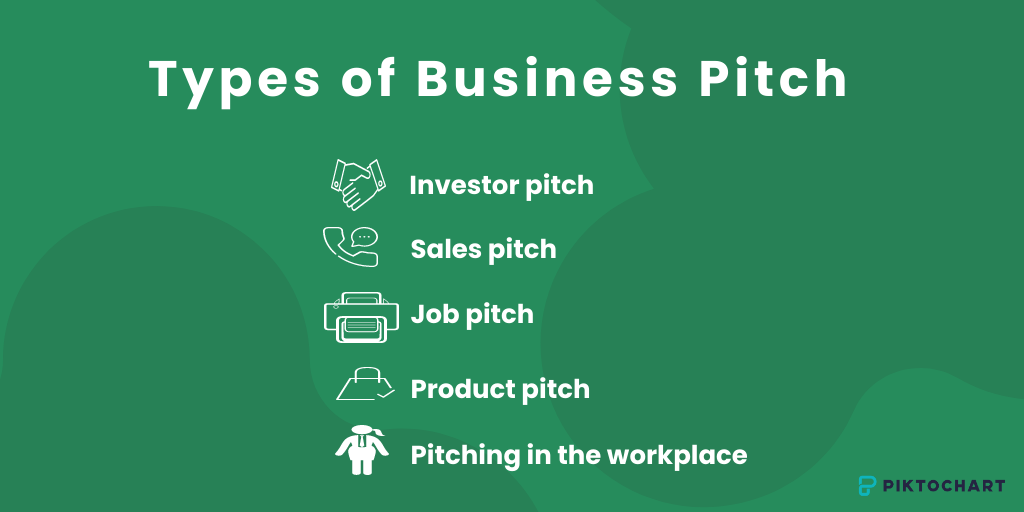
Your business pitch can be narrowed down to the following five types of presentations:
1. Investor pitch

In this type of business pitch, you present a persuasive presentation or pitch deck to a group of potential business partners and/or investors.
Sign up for a free Piktochart account to get started on creating professional-looking pitch deck templates that you can edit in minutes.
An investor business pitch should typically last for 45 minutes . The best practice for this type of pitch is 20-30 minutes of presentation followed by discussion or a Q&A afterward.
Alternatively, business pitch competitions follow a different best practice. These presentations should last around five to 10 minutes and focus on pitching to investors.
Lastly, the most stringent type of business pitch is most commonly referred to as an ‘elevator pitch’, and should only last around 30-60 seconds.
Let’s dive in so you can learn how to make the perfect business pitch!
2. Sales pitch

The goal of a sales pitch is to answer the question “What’s in it for me?” from the lens of the potential customer.
The best and most effective salespeople can make a sales pitch in as short as one minute. Also known as the ‘ elevator pitch ‘, this type of business pitch should be able to be delivered in a single elevator ride (30-60 seconds on average). In this format, a short sales pitch should include four key components:
- Your unique product name and category
- The specific problem you are trying to solve
- The innovative solution you offer
- the unique selling point of benefit to your solution
3. Product pitch

A product pitch is similar to a sales pitch, however, the spotlight should be on the product and/or solution itself.
For example, a sales pitch for an email automation software will highlight one or two of its benefits. Meanwhile, a product pitch of the same automation software will focus more on its features, how it works, and how you can integrate the software into your existing setup.
In a product pitch, you should aim to:
- Explain your product or offering clearly and concisely
- Identify and address the target audience and/or industry your product supports
- Specify the problem the aforementioned faces and how your solution can solve it
- Provide a realistic example of your solution in action
- Make sure to use accurate facts backed up by relevant and recent data
4. Job pitch

If you’re applying for a job or internship and you’re wondering how you can stand out from the crowd (consisting of your peers and other qualified applicants), consider pitching yourself to a prospective employer.
Applying the same logic used for a sales or product pitch deck; sell yourself!
A job pitch or personal summary pitch should be concise, personalized, and consistent. In a job pitch you should include:
- A brief introduction to you
- An explanation as to why you’re a great fit for the company and role
- Relevant experience and achievements
- Your goals and career aspirations
“It’s not about bragging or showing off — it’s about giving the other person evidence that you can actually do what you say you can do,” assures Starla Sampaco , TV news anchor at KCTS 9 and founder of Career Survival Guide .
5. Workplace pitching
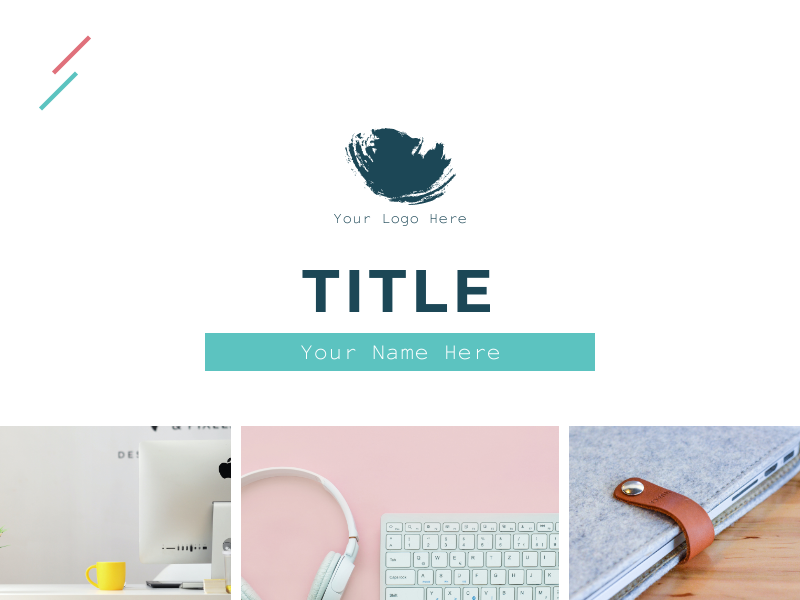
Do you have an idea or initiative that will help your colleagues and help boost the company’s profitability? Pitch it internally within your workplace, to your team or boss!
For example, you can pitch a remote-first culture or the four-day workweek to your HR, and/or the rest of the leadership team.
Another workplace pitch example? Maybe you might want to propose the creation of a new role in your team which can help advance your career and address a challenge in the organization at the same time.
To do this, simply create a pitch deck including your main points, the benefits, and proposed next steps to turn your idea into a reality. Piktochart’s workplace pitch decks can help you get your point across through our workplace templates.
The structure of a successful business pitch
If creating a business pitch sounds intimidating, the team at Piktochart has your back.
You can address this worry by making sure that you have a business pitch structure that is sure to succeed, using our tips & templates.
When you have a formulated pitch deck structure, template, and agenda, you’ll know exactly what you’re going to say next, taking the bulk of the stress out of presenting. Additionally, these best practice presentation structures make your business pitch more memorable to your audience and leave a lasting impression. Statistically, it turns out that people retain structured information up to 40 percent more accurately than information presented in freeform.
The WHAC Method
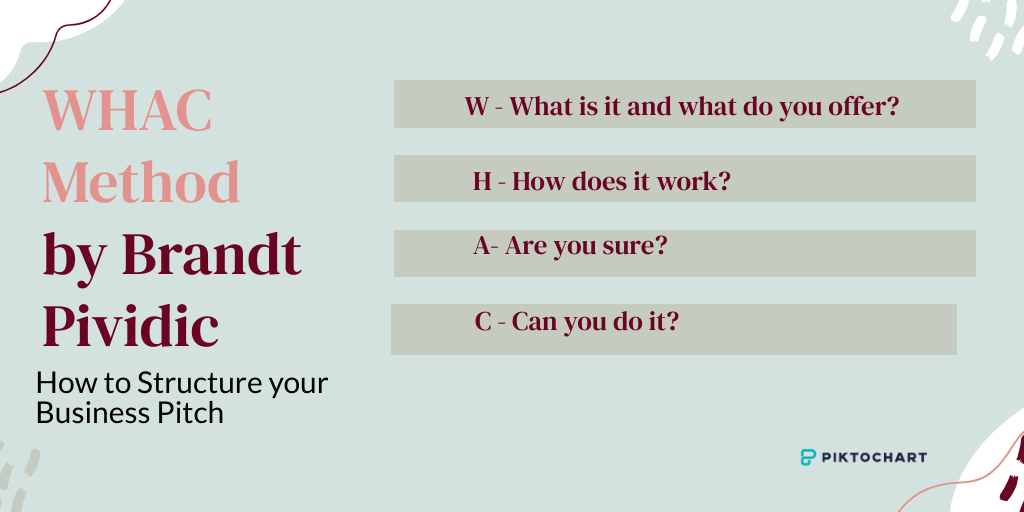
Whether you’re pitching to a group of potential investors or you’re selling real estate, use the WHAC method when structuring your perfect business pitch.
The WHAC method is introduced in The 3 Minute Rule by Brandt Pividic, an award-winning film director and television producer. He wrote the book to detail his experience and tips as he made hundreds of pitches in Hollywood.
This well-known WHAC method stands for:
What is it and what do you offer?
You start your business pitch by answering the questions: what is it, and what do you offer?
At this point, you share your business plan and quickly outline the problem and solution you offer. For example, let’s say that you want to pitch the idea of having a UX researcher on your product team.
You list down existing problems and challenges that your team and/or organization are currently experiencing without a dedicated UX researcher. Afterward, you propose your solution — hiring someone who can step in and do user research.
How does it work?
Next, explain your proposal. Provide a quick summary of the benefits of your solution. In our example, share how the UX researcher will help the product team accomplish its objectives.
It can be tricky explaining how your business idea works. Figuring out how to deliver this information in an entertaining and simple manner can turn potential investors into partners, as we’ve seen from some of the best startup pitch decks .
Since you don’t have much time and attention spans are short, the key is to boil down how your idea works into a few key points. Explain how it works from a high-level overview and weave this in as part of your compelling story.
Are you sure?
Once you have provided the solution, the people listening to your elevator pitch are likely saying to themselves, “will it really work?”
This is the point where you have to provide solid proof in your pitch. You can use testimonials, a short case study, or statistics.
You should also mention financial projections in order to leave a positive impression. If your manager or potential investors will provide funding for your idea, they’ll want to know what the ROI is.
Can you do it?
The final part of your pitch should answer this question.
Now that your audience has heard you talk about the problem, solution, and proof that it works, you need to show them how you’re going to implement the solution. Think of this point as the “actionable” part of your pitch. You can even provide steps to break down how this can be achieved in a certain timeframe.
“Show how you have thought about how to turn your idea into a commercial outcome or true partnership. This is really an opportunity to start or continue building trust and showing that you care about creating real value for the people in the room is the best way to put you on the right foot,” shares Michael Rosenbaum , CEO of Spacer , one of the biggest parking marketplaces in the U.S.
Like any good sales pitch, you need to show how achievable the results are. At this particular stage, you need to tie in any additional information to show what resources or specific and unique skills are required to make it happen.
Being transparent about what’s required can build trust with potential investors.
How to persuade your audience with your business pitch
Now that you know the best practice structure of a successful business pitch, take note of the following tips to help make your business pitch more interesting, relatable, and most of all, convince your audience to say “yes”.
1. Understand what your audience wants from you
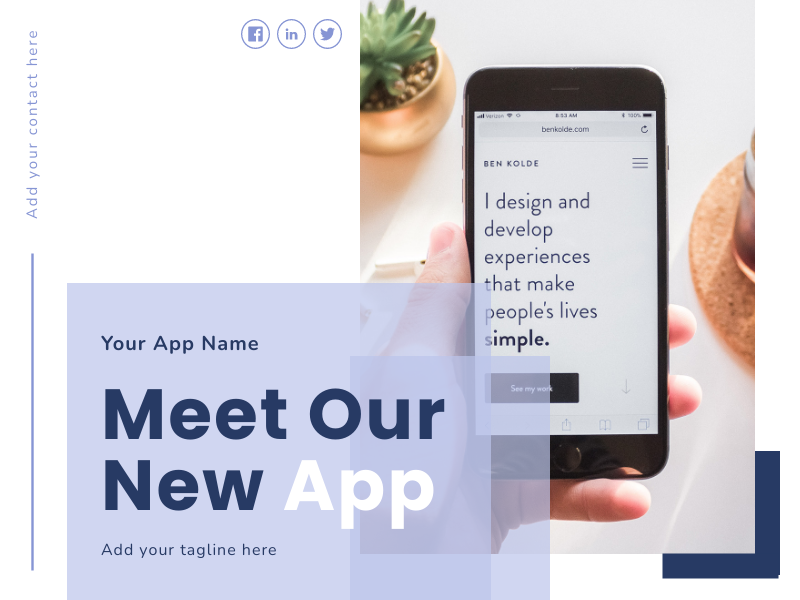
It’s standard advice across all facets of industry to “know your audience”.
However, if you’d like to become better at your business pitches, go the extra mile by understanding what your audience wants from you.
There’s a difference between understanding and knowing your audience. Instead of just knowing where your client comes from, try to understand their pain points, goals, and motivation.
How do you do this?
Talk to them in advance, read about the things they publish online (tweets, blog posts), and understand what excites them. By doing so, you’ll be able to tailor your business pitch to their needs, wants, and preferences.
For example, if you’re pitching to potential clients and investors who are eco-conscious at the same time, it makes sense to highlight how your idea can positively impact the environment.
Stephen Keighery , CEO of Home Buyer Louisiana and Founder of Bald Eagle Investments USA, shares this tip when it comes to customizing your pitch to your audience:
“Learn ahead and research about the company or the client you’ll be pitching to, just be sure that every information you obtain is for public knowledge. You can also observe their behavior and their words during the transaction; and perhaps while pitching, use the jargon they use to establish connection and a favorable impression to them.”
2. Have your elevator pitch ready

Imagine this. You just bumped into Mark Cuban of Shark Tank at the airport lounge, and you can’t believe that you’re sitting next to him! He looks at you and asks you about yourself and what you do.
This is when you need your elevator pitch handy!
The Asana team recommends the following elements of a good elevator pitch :
- Introduction
- Value proposition
- CTA (call to action)
You don’t have to follow the exact formula. You can mix it up based on the situation, your personality, and the audience you’re pitching to.
It’s also worth noting that you might not immediately notice the benefit of your elevator pitch. Think of it as an opportunity for you to make a great first impression.
3. Use visual aids
If you have the chance to present beyond the elevator pitch, you should never pitch with a presentation that’s filled with texts, numbers, or endless rows of data.
As humans, our brains are hardwired to love visuals — from photographs to infographics to icons.
When pitching an idea, product, or service, get your audience’s attention (and support!) by telling a story visually and adding a bit of creativity to your PowerPoint slides.
Images trigger empathy which in turn can make your audience understand your pitch better.
The more they understand your idea, the greater the likelihood of angel investors, venture capitalists, and potential customers supporting or advocating for you.
Another added benefit is that visuals can elicit emotions and emotions play an important role in decision-making.
Watch these 10 legendary pitch decks for visual inspiration.
4. Explain your business model clearly

When pitching to investors, imagine them asking, “what’s in it for me?”.
After learning about how your idea can help solve a problem, they’re interested in how you’re going to advertise to your target market and generate revenue consistently.
Johannes Larsson , CEO of Financer.com explains that being able to articulate their business model was what made them successful in getting business partners on board.
“We were relatively unknown in the industry, so it took us quite a few tries before we signed our first deal. After that, however, things became much easier — not just because we were building up a name for ourselves but also because we improved our approach. We learned that being able to clearly explain our business model was the key to earning potential partners’ trust. Once we mastered that, we focused on providing proof of fruitful partnerships. It was obvious that this information was what our affiliates cared about, so we made sure to gather evidence of our success and present it in every pitch.”
5. Weave your passion or story with your pitch

Your business pitch doesn’t have to sound like you’re reading it straight from a script that someone else wrote for you.
When appropriate, add a bit of your personal touch. In short, humanize your pitch and slide deck.
It will not only improve your relatability factor but also make you feel less nervous. After all, you’re talking about something that you’re passionate about.
Take it from Debbie Chew, an SEO Specialist at Dialpad .
“As part of my hiring process, I had to pitch a marketing campaign idea. I started brainstorming a list of potential ideas and their projected impact to decide which one to go with. While doing this, one idea kept coming back to me, and I realized I was most passionate about pitching a campaign related to video meetings. People now spend so much of their time in video meetings, but how much time? And how can we have better meetings? So I built my pitch around this concept and really enjoyed pitching my idea (which also helped me feel less nervous),” shares Chew. If you can share a personal story or something you’re passionate about in your pitch — while also tying it back to your audience — they won’t forget it. And yes, I got the job!”
6. Put the spotlight on benefits

Once you have your audience’s attention, circle back to how your product or service will address customer needs and benefit business partners.
For Carsten Schaefer of Trust.io , it boils down to being able to share the benefits of your product or service from the get-go.
“When I first had to get funding for my product, I had to deliver a sales pitch in front of a board of investors. It didn’t succeed, and I learned a lot from it. “Investors want cold, hard facts and the benefits to the end-user. In the end, they want to see if it makes money for them or not. I’m glad I failed because I learned that for an effective sales pitch, you really need to put yourself in the shoes of someone thinking about profit and pure common sense from a business perspective.
Create a successful business pitch
Select a template that sparks your imagination. Clone, add or delete blocks. Visualize concepts, processes, lists, timelines and data. Use charts and graphs. Sync them with spreadsheets. Export the visual in PDF or PNG format. Start for free.
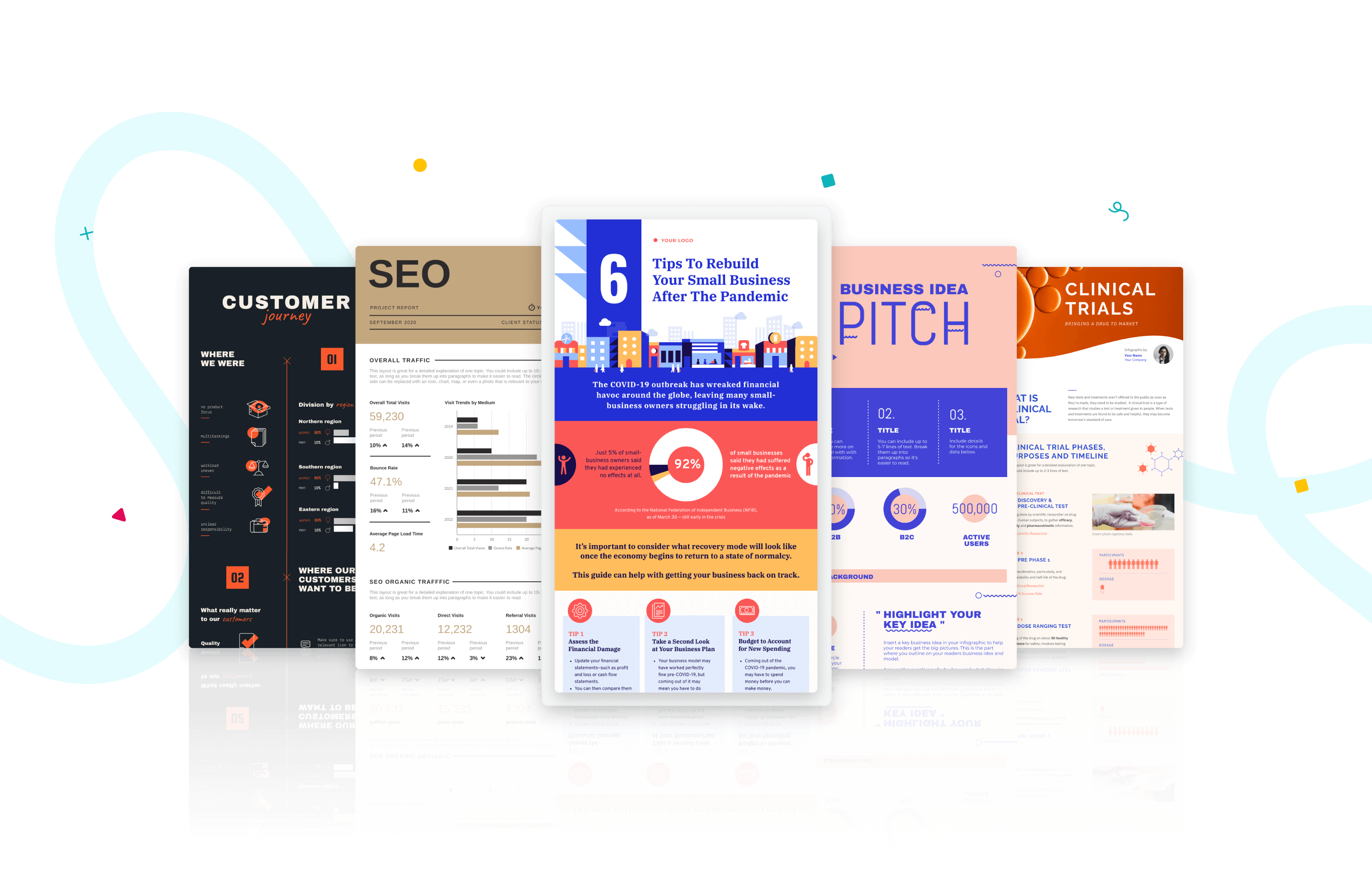
7. Highlight why you’re different from the competition

Your business pitch is also an opportunity for you to explain what sets you apart from other businesses or organizations, and essentially explain your unique selling point. What makes your idea different? Why is your business model unique?
It also helps to address relevant competition head-on in your pitch. For Brogan Renshaw of Firewire Digital, this tactic shows clients and investors that you’re an expert on what you are talking about, giving them confidence in your offering.
“I notice that this is a part of my business pitches that completely wins the client over because it answers their questions and concerns on the market position of competitors,” says Renshaw.
8. Share the story behind your team

Investors and business partners are also curious about the people, employees, as well as the team behind your idea. When creating this presentation slide in your pitch deck, don’t forget to include information highlighting your team and each team member’s relevant skills.
“Investors want to know whether the founders have worked together before, if your startup’s early hires have complementary skill sets, and whether you’ll be flexible, open-minded, and willing to embrace different perspectives, “ writes Lauren Landry , associate director of marketing and communications for Harvard Business School Online.
9. Have an impressive one-pager
As its name implies, a one-pager is a one-page document outlining your business plan and mission. Think of it as a business brochure . With Piktochart’s online brochure maker , you can easily create one within minutes.
Imagine that an investor or client is too busy to listen to your pitch, you can simply email or hand out your one-pager; your entire business pitch in an easy-to-digest format.
According to Greg Cullen , Sr. Account Executive at Dialpad, your one-pager should have these three components:
- What is the business pain?
- How the solution you’re positioning can solve said business pain
- The value of the solution accompanied by the resulting positive impact by moving forward with the platform
“This one-pager condenses everything that is important succinctly into an easy-to-digest easy to digest format for everyone to read – and it ensures that all parties are on the same page. And most importantly, this can be used by the champion you’re working with to sell this internally, whether it’s to the CEO, procurement, etc. The better you make this one-pager, the better the result you’ll have,” recommends Cullen.
Get funding, win clients, and gain support with Piktochart’s pitch deck creator
While it may be nerve-wracking, particularly if it’s the first time that you’re creating a business pitch, use the expert tips above as your guideposts for a successful pitch.
You’ll eventually find your very own unique style and approach to business pitching as you do it more frequently.
If you need help creating any type of business or personal pitch deck, create your pitch deck quickly with Piktochart’s pitch deck creator. The first step is to get your free Piktochart account .
Want additional insight on how to better prepare and deliver a business pitch that you’ll be presenting online? Go to our guide to stress-free, engaging Zoom presentations .
We’re rooting for you and your business!

Kyjean Tomboc is an experienced content marketer for healthcare, design, and SaaS brands. She also manages content (like a digital librarian of sorts). She lives for mountain trips, lap swimming, books, and cats.
Other Posts

Mastering the Craft: Presentation Design Strategies From a Pro

How to Make a Presentation (2023 Guide With Tips & Templates)

How to Nail Your Brand Presentation: Examples and Pro Tips
Do you want to be part of these success stories, join more than 11 million who already use piktochart to craft visual stories that stick..
- SUGGESTED TOPICS
- The Magazine
- Newsletters
- Managing Yourself
- Managing Teams
- Work-life Balance
- The Big Idea
- Data & Visuals
- Reading Lists
- Case Selections
- HBR Learning
- Topic Feeds
- Account Settings
- Email Preferences
How to Make a Compelling Pitch
- Matt Abrahams

A simple formula to create a concise, memorable pitch on the spot.
If you want to be an effective communicator, you’re going to need to know how to pitch your ideas, concepts, and perspectives to others in both professional environments and day-to-day interactions. To be effective, a pitch needs to be understandable, relevant, and readily convincing — without any strong-arm tactics or perceived gimmicks and tricks. And in today’s rapid-fire, short-attention-span world, it must also be concise. In this article, the author offers a simple framework for how to craft a compelling pitch. It comes down to completing four simple sentence starters: 1) What if you could… 2) So that… 3) For example… 4) And that’s not all…
You may not have “marketing” or “sales” in your job title, but chances are, you’re still in the pitching business. That’s because most jobs require the ability to influence, persuade, and convince others. Whether you’re presenting an alternate approach to your team project during the morning scrum, lobbying for a promotion, or trying to convince your neighbors to support your idea to turn your cul-de-sac into a pickleball court, you’re pitching.
- Matt Abrahams is a lecturer in organizational behavior at Stanford Graduate School of Business. He hosts Think Fast, Talk Smart: The Podcast and is the author of Think Faster, Talk Smarter: How to Speak Successfully When You’re Put on the Spot .
Partner Center
What is a Pitch Deck Presentation? and how to create one
A beginner’s guide to the pitch deck meaning
This article will guide you through understanding what is a pitch deck presentation, and empower you to create a compelling one that aligns with your company goals.
What is pitch deck?
A pitch deck is a 10-20 slide business presentation designed to give a short summary of your company, your business model, your traction, and your startup vision. A pitch deck can be used for several purposes, from trying to get a meeting with an investor, to presenting in front of an audience during a demo day.
Different scenarios and time constraints allow adding more or less information, but the basic structure remains similar. The pitch deck definition can be summarized as the following: the story of a startup, its milestones, and its ability for exponential growth.
The story of a startup, its milestones, and its ability for exponential growth.
When do you need a pitch presentation?
A pitch deck is usually needed at several stages of a startup’s life. Most US accelerator programs will require you to submit a pitch deck of your company as part of the initial screening process. If you’re admitted to one of these programs, they will also have what is called “pitch practice” that basically consists of pitching sessions where the founders of each startup take turns and rehearse presenting their deck out loud. These sessions are meant to prepare founders for the accelerator demo day, where all companies from the batch present in front of an audience of stakeholders including investors and program managers.
The most common use of a presentation deck, however, is when companies decide to raise venture capital from investors. It has become an industry standard to use a pitch deck when having interactions with investors, whether as a send-out document that is shared prior to meeting in person or to go over your value proposition if you get an actual meeting with them. This deck presentation serves a dual purpose: it allows investors to quickly go over your business proposal in a way that’s easier for them to assess the investment opportunity, but it also forces you to think about the building blocks of your company and pen down key pieces of information about your startup.
What should be in a Pitch Deck Presentation?
A number of authors, venture capitalists, startup founders and evangelists have created different versions of what they consider required elements to successful pitching presentations. Most of them agree on the following:
Pitch Deck Structure:
- Product/Features
- Market Size
- Business Model
- Competition
- Go-To-Market
- Traction / Milestones
- Fundraising/Use of Funds

These core sections actually follow a deliberate structure that goes from general to specific, from providing the context for the business opportunity to explaining why this company can fill in a market gap.
If you’re looking for pitch deck examples you can check out our curated gallery of pitch deck templates here .
While this structure is pretty much a common denominator in the startup ecosystem, it is worth noting that companies at different stages will adapt their storytelling to better fit their strengths. Because they have little to no traction, early-stage startups usually rely more heavily on the problem-solution sections, the market opportunity, and being first-to-market. Later-stage companies on the other hand bet more aggressively on showcasing their revenue traction, their financials, and the ability to grow the business if more capital is injected into the business.
Regardless of the size of the company or the milestones to date, the ultimate goal of a pitch deck presentation is to provide a blueprint for how the startup works, its strengths, and future growth opportunities.
The ultimate goal of a pitch deck presentation is to provide a blueprint for how the startup works, its strengths, and future growth opportunities.

Are there different types of pitch decks?
More than different pitch decks per se, there are different types of pitching needs or scenarios, and so the basic narrative is adapted to fit different time constraints and content requirements. There’s no universal rulebook when it comes to pitch deck types, but here are some of the most common pitch deck types:
- Elevator pitch deck: a super summarized version of your pitch deck. As the name suggests, the idea is that this pitch should be delivered during an elevator ride with an investor. While this is obviously figuratively speaking, elevator pitches are usually covered in 2-3 minutes, they should leave out any granularity, and they should focus on the most essential pieces of information.
- Demo day pitch deck: typically a little longer than an elevator pitch, but similarly falling under the short-ish side of the spectrum. Demo days usually jam together entire batches of startups and thus constrain each founder to keep their presentation under 5 minutes or so. They are usually presented in large auditoriums so they should have as little text as possible and make things more visually appealing by means of photos/images.
- Full investor deck: This is what you would normally find when looking for whats a pitch deck. This is the archetypical pitch deck , and the most widely used. It is a full-length presentation that showcases your company for an investor to review and assess your fundability. This is a more in-depth look at all the aspects of your startup, from business model and go-to-market strategy to financial projections and fundraising needs. These decks usually range from 15-20 slides, and they provide a full picture of your business. These decks are sometimes shared so people can review them without a presenter, so they allow the addition of more information. They can also be used to guide an in-person meeting and help the founder highlight traction data that would otherwise be trickier to explain verbally.
- Investor data room: An investor data room is a digital compilation of all the due diligence of a startup as the closing of an investment approaches It extends beyond the pitch deck and covers other important documents that validate your company’s credibility and support the information shared throughout the deck. When an enterprise wants to buy a company, this information helps investors ensure everything is in order. In the investor data room, investors check that everything you pitch is real: your legal structure, your contracts, stock vesting agreements, trademarks, and financial data. For more information on this topic, you can check this article .
.webp)
What makes a good pitch deck?
A good pitch deck successfully combines these key ingredients:
- Good story structure - storytelling arch: When it comes to pitch decks, the order in which you present your information is almost as important as the actual information on the slides. The information should follow a sequence that makes sense to grasp the full scope of your business. Most, if not all of the storytelling best practices for public speaking apply to the context of telling business stories.
- Easily understandable: Closely related to the previous point, the information on the slides should be easy to understand and follow. This means the information should be phrased in a way that even someone who’s not familiar with your industry can still understand the value proposition. A lot of tech companies fall into the trap of including technical jargon in order to sound more knowledgeable or gain credibility, but this usually backfires in making the information less accessible. Keep things simple and don’t overcomplicate your message.
- Human-centered & relatable: It’s tempting to focus too much on the solution you created and give lengthy explanations of your product’s features and capabilities. The reality is that the best product is meaningless if it doesn’t solve a real human problem. Make things relatable by providing proof of the user pain points, and how your solution improves their lives. If your audience can’t relate to the problem, it’s going to be hard to convince them of your solution.
- Compelling visual resources: While the content of the presentation is important, it is also critical to pair up this information with visually appealing imagery in order to make the slides more engaging. People get bored easily and a graphically rich presentation can help the viewers make a better connection with the information that is being delivered. We process images faster and easier than text, which is an abstract form of communication. Leverage this in your favor by making striking slides that elevate the content in them.
- Traction-oriented slides: The best pitch decks bet on traction more heavily than any other content on the deck. This is because nothing provides more credibility to a business than showing the data of actual paying customers.
- A healthy, exponentially growing business: The simplest (but hardest) truth about making a pitch deck is that the best ones usually depend on a company’s performance. A revenue-generating business, a low-churn product, a company with exponential growth and healthy engagement with its users… these are the things that spark investor interest. The hard truth about the startup world is that investors want to 10x their investment, and despite having a reputation for being risk-takers, their real expectation is to have returns on their investment.
A pitching presentation is a great tool for both founders and investors to evaluate business opportunities together. It forces you to tell the story of your company in a comprehensive way, and it allows potential investors to learn about your startup in a framework that they’re familiar with.
It lets you convey the market opportunities you’re business has found, and provides the medium to explain how your product and business model are the key to unlocking massive scale and ROI.
I hope this article has been able to answer what is a deck in business. Feel free to check out other articles in our blog that cover pitch deck basics.
Start your Pitch Deck
Popular articles.

How Startup Equity Works: Pies vs. Bricks and the Value of Shares

10 Elevator Pitch Examples from Successful Startups

Customer churn: how we cured our startup cancer

How to design a Pitch Deck for Investor?

Let’s move your company to the next stage 🚀
Ai pitch deck software, pitch deck services.

Financial Model Consulting for Startups 🚀

Raise money with our pitch deck writing and design service 🚀

The all-in-one pitch deck software 🚀

Learn how to create a compelling slide deck for your startup. Explore how to use slide decks as aids for your presentation, and the most common uses for them.
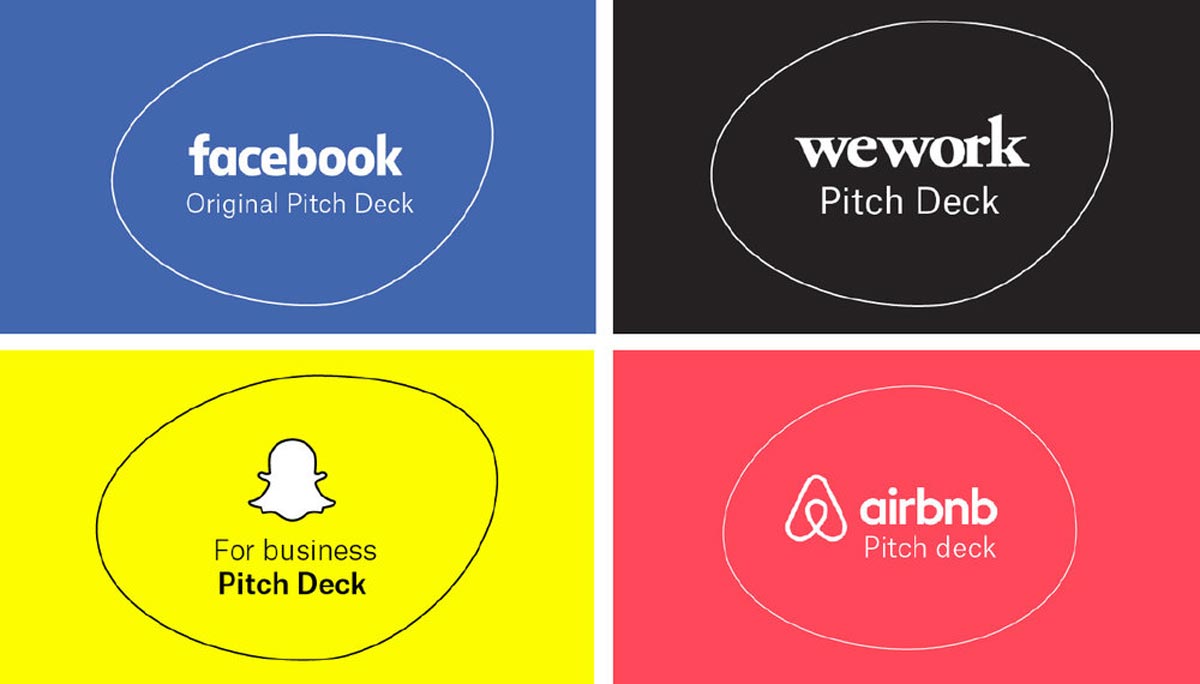
Find here the best 35+ pitch deck examples and templates from successful startups like Airbnb, Uber, Tesla, free to download and get inspired.

This is a functional model you can use to create your own formulas and project your potential business growth. Instructions on how to use it are on the front page.

Book a call with our sales team
In a hurry? Give us a call at
9 Sales Pitch Examples (Plus Tips on How to Write Your Own)

FREE PITCH TEMPLATES FOR SALES TEAMS
Looking to expand your client base? Look no further! A well-designed pitch deck can be the key to success.

Updated: 09/07/23
Published: 09/01/23
Your sales pitch can make or break the deal, so it‘s a good idea to have that nailed down before meeting with your customer. It’s your opening line, your verbal business card, and the first thing your customer will hear when you call or meet with them.
I've been in sales for almost 16 years and have heard my fair share of both great and less-than-stellar pitches.
For this post, I‘d like to discuss the anatomy of a good sales pitch and share examples of the best sales pitches I’ve ever heard.
![how to write a pitch presentation Download Now: 4 Customizable Pitch Decks [Free Templates]](https://no-cache.hubspot.com/cta/default/53/6973e3b5-7aca-4e23-9231-b786d3bbafd0.png)
What is a sales pitch?
How to start a pitch.
How to Makes a Sales Pitch
The Sales Pitch Framework
Sales pitch ideas.
Sales Pitch Examples
A sales pitch is a condensed sales presentation where a salesperson explains the nature and benefits of their business, ideally in less than one or two minutes. Sales pitches are often referred to as ‘elevator pitches’ because they should be able to be delivered within the time constraints of a single elevator ride.
Salespeople are past the point of giving prospects hour-long presentations to sell products or services. Nobody has that kind of time and, to be honest, if you need an hour to relay your value proposition, you're doing it wrong. (Psst: If you need help creating a value proposition, we've got you covered.)
They're called elevator pitches for a reason. Ideally, if you're giving me one, I should be able to understand what you have to offer in the time it takes to get from the lobby to my floor.
A good salesperson should be able to get their message across compellingly and concisely. If you can nail your sales pitch, odds are you'll have more time to talk down the line.
.png)
Download Now: Free Elevator Pitch Templates
E-pitch templates to better sell your product, fund your business, or network.
- 4 Fundraising Pitch Templates
- 2 Networking Pitch Templates
- 2 Sales Pitch Templates

You're all set!
Click this link to access this resource at any time.
What is a product pitch?
A product pitch is not much different than a sales pitch, but is specifically focused on a product or service. You'll go in-depth and emphasize how your product works, how it will solve their pain points, and the specific benefits it will bring to your customers.
As an example, a sales pitch can be broadly focused, like if you‘re a consulting firm that offers a wide range of services. You’re selling your business as a whole, rather than a specific product or service, like a CRM platform or accounting tool.
Starting a pitch is arguably the hardest part. You have to grab your prospect’s attention so that they actually want to hear the value of your product and how it can help their business. But before you can share the product’s value, you have to hook the prospect.
When starting your pitch, you’ll want to integrate the following essential elements.
- Start with the problem. Always start with the problem. Unless they know the problem you can solve, they won’t be open to hearing how your product is a solution.
- Tailor the start of the pitch to their vertical. No one wants to hear a general pitch that would apply to any business. Research their vertical and use the information you found to personalize the pitch immediately.
- Offer stakes. If they don’t solve the problem using your solution, what do they have to lose? You don’t need to state it in such clear terms — but alluding to the risks at the start of your pitch can help you secure buy-in straightaway.
Here are a few methods for starting a product pitch, but remember: try to stick to thirty seconds, or one to two sentences if you’re delivering the pitch via email.
Start off with a personal anecdote.
Start off a pitch with what you know best — yourself. While I don’t think you should focus solely on yourself throughout your entire pitch, starting off with a personal anecdote can help you speak with more authenticity and foster empathy.
The key here isn’t to focus on the product’s merits. How many product pitches start off with “This product helped me achieve X results in X amount of time”? A lot. And I’m already yawning. And no one cares about results unless they know the problem first.
Your personal anecdote should focus on a problem that your product can solve. Make it as excruciating as you’d like — and don’t forget to be genuine and connect your anecdote to their business.
Ask a question that relates to the problem you solve.
Oh, yes, the good old question. While it might verge on overused, it’s not to be dismissed. Asking a question is a highly effective way to start a pitch. The question should, again, focus on the problem.
Stick to yes or no questions and tailor it specifically to the business you’re pitching to. If you’re speaking to a real estate business, create a question that articulates a problem specifically experienced by real estate firms. If you sell a property management software, it could be as simple as, “Do you spend way too much time tracking individual property sales? That’s time better spent actually showing homes to prospective buyers.”
Start with a stat that resonates and offers stakes.
Starting with a stat can be effective — but it has to resonate with the audience and offer stakes. In other words, what does the stat have to do with the problem? How does it reflect a potential and critical downfall that could harm your prospect?
Let’s say that you’re a salesman of yard maintenance services. Starting off with “50% of homes don’t use yard maintenance services” is a lazy and boring way to begin your pitch. Consider instead: “50% of homes don’t use yard maintenance services, resulting in thousands paid to HOA every year.”
Now that you know how to start your pitch, it’s time to deliver the rest of it. Use the following tips to secure buy-in in less than three minutes.
How to Make a Sales Pitch
- Make it short.
- Make it clear.
- Explain who your customers are.
- Explain the problem they're facing.
- Explain how your product addresses their needs.
- Describe what success will look like as a result of using your product.
1. Make it short.
A sales pitch isn‘t a conventional presentation. You’re not going to have PowerPoint slides. You‘re not going to have complimentary pastries on a boardroom table. And, most of all, you’re not going to have your audience‘s time and patience for long — at least not until they’re sold on your product.
2. Make it clear.
This ties in with the previous point. You don‘t have the time to go on tangents or talk about anything but the message you’re trying to get across. Your pitch has to be lean and to the point. It has to register with your listener immediately. That means speaking with intention and clarity.
If you’re pitching a product, you want to ensure that you clearly communicate how it will solve your prospects' pain points, giving them a clear picture of how their day-to-day will improve if they decide to make a purchase.
3. Explain who your customers are.
Consider the picture you‘re going to paint in your pitch. Give your listeners perspective on who’s buying your product or service. They want to know that you have a lucrative, engaged market in mind. Be specific in identifying who will be interested in your product, and try to convey why your listeners should be interested in them.
4. Explain the problem they're facing.
Cover why your customer base needs you. Your target market is only as valuable as the problems you can solve for them. Convey a problem they consistently face. If you‘re pitching a spreadsheet software for accountants with functionality Excel doesn’t have, you could discuss how hard it is to bookkeep without your software's unique features.
5. Explain how your product addresses their needs.
Here‘s where you start to bring it all home. You’ve established who you‘re selling to. You’ve established why you‘re selling to them. Now, you have to establish why they’d buy from you. What can you do better than your competition?
Robin Piree, filmmaker and creator of RobinPiree.com even notes, "Buyers are focused on their needs, and sellers are focused on the details of their offering. The goal of a successful pitch deck is to switch your focus from what you offer to how that meets your buyer's needs."
As mentioned above, you need to clearly explain how your product addresses their needs. Continuing with the accounting example, you could touch on how your unique data visualization features make busywork more efficient.
6. Describe what success what success with your product will look like.
Show the benefits of your product on a broader scale. In the example we‘ve been using, you can talk about how accountants that use your software have more time to spend with important clients or the flexibility to spend time with their families. Show how your product makes your customers’ lives better as a whole.
Ideally, your pitch should be a one-liner summarizing what your company does, how they do it, and for whom. And this is not just a requirement for sales reps. Anyone in your company, from the CEO to sales consultants, needs to know your one-line sales pitch by heart.
So, how should you structure your sales pitch?
If you have time to properly expand and work on a conversation, touch on points of interest. Here's a framework you can use for building your pitch:
- Problem: Start with a statement or question about the problem you solve. You can present the problem using a personal anecdote, question, or eye-opening statistic. Answer the why.
- Value Statement: Share a very clear, concise statement of value. Be action-oriented and outcome focused. Avoid using jargon. Share benefits.
- How We Do It: Highlight unique differentiators and explain what you do.
- Proof Points: Provide clear reference examples and list recognizable achievements. Share industry validation and awards.
- Customer Stories: Share customer examples and successes. Tell emotional and personalized customer stories. Make it real and tangible.
- Engaging Question: Close the pitch with an open-ended question, creating a space to have a conversation.
Many companies use success stories in their pitches to ensure the sale. Name-dropping really works, so be sure to use that to your advantage. And if your product is small or light enough to keep in your pocket, you should always have one on-hand to show your prospect.
I always stress the need for a concise sales pitch. So keep it free of professional jargon, don't get into the weeds, and be sure to talk more about your prospect and their problems than yourself.
Nothing‘s more off-putting than a bragging salesperson talking about themselves, their company, or their services. That’s what I call the “me monster.” The actor in your story is the customer, not you — period.
Distribution Matters
Lastly, presentation and distribution are everything. You need to deliver your sales pitch to the right person at the right time with the right tools on hand (like a demo, free trial, or presentation).
The sale starts with your list of contacts. Define your list and personas, know their correct contact information, get an introduction, and make sure you contact them at a time of day when they're likely to respond.
- Tell a story.
- Include a value proposition.
- Personalize the sales pitch.
- Switch up your pitch.
- Practice your pitch.
- Try not to use metaphors.
- Create a WOW moment.
- Appeal to emotions.
- Back it up with facts.
- Tap into their fear of missing out.
- Educate them.
How can you make your sales pitch the best it can be? Here are some sales pitch ideas.
1. Tell a story.
Keep your listeners engaged by telling a brief story . The story could be either about the company or how a customer found success through your product or service. In this latter example, you can start with the issue the customer was facing, lead into the solution, and end with the key results the customer achieved.
If you think storytelling is difficult, don’t fret. Just think of your favorite movies and TV shows — how did they keep you engaged? Try to emulate the same tricks as you try storytelling during a sales pitch. Use images and interactive elements to enrich the experience for your listeners, keeping in mind who your audience is and what their preferences are.
For instance, if you’re selling enterprise-level software to senior-level executives, you might adjust your tone and delivery to be more formal and poised. The scrappy owner of a startup, however, might appreciate more humor and levity. Study your prospects to figure out the best storytelling method for them.
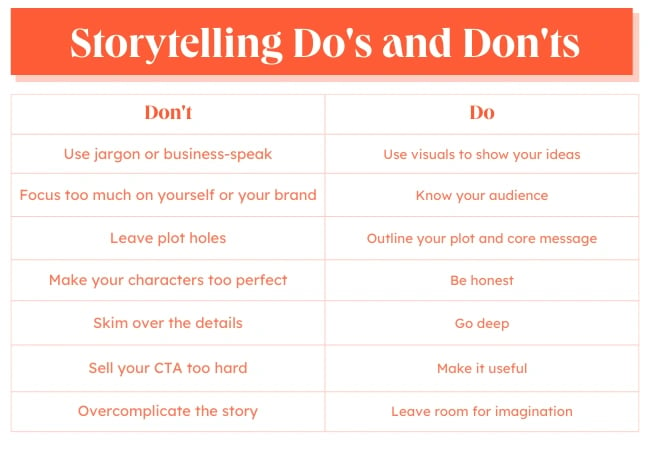
2. Include a value proposition.
What value will you provide for this person or their company? While your pitch should be short and sweet, the value proposition is the core of your sales pitch. To offer the greatest amount of impact, your value prop should come after you identify the problem that your prospect faces in their day-to-day. The value prop is the proposed solution and is the make-or-break moment of your pitch.
Create a value proposition canvas to guide the wording of your value prop. Remember that the gain creator and pain relievers connect directly to the customer gains and pain points. Leveraging these two sections of your canvas will help you create a pitch that directly speaks to your prospect and their needs.
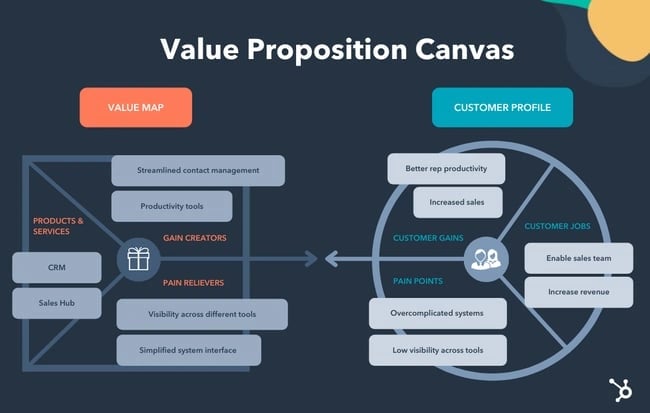
3. Personalize the sales pitch.
Who are you talking to? Make sure your sales pitch is relevant to them and piques their interest. You‘ll be able to customize it so it addresses the items that are most important to the person you’re speaking with.
This idea applies to any pitching method or technique you use. No matter what, the sales pitch should speak to your prospect’s highly specific pain points and needs. For instance, if you’re pitching your bookkeeping software to the sole proprietor of a freelance business, you might emphasize the easy and simple invoicing tool.
For personalization to have the most impact, you must have had a productive discovery call where you asked questions that uncovered your prospect’s most urgent needs. Leverage the information you found out during that process to hone your pitch.
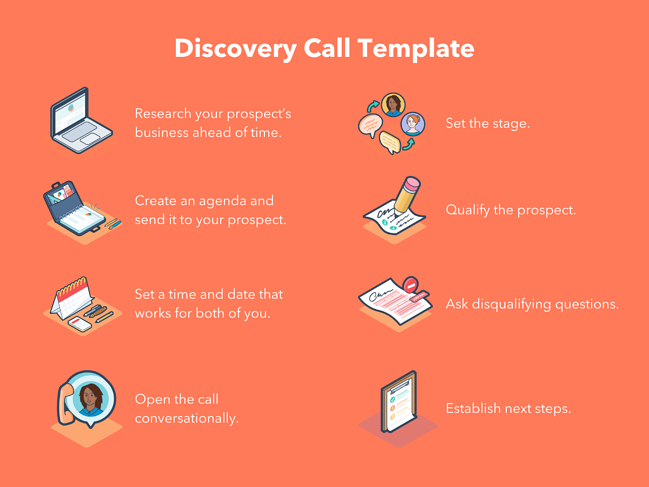
“How many times have you found yourself in a spot where you absolutely loved how you or your subject looked in a picture; however, something still seemed to be wrong about it as a whole? In most cases than not, that ‘something wrong’ is the image background. An ill-looking background can potentially drop down the appeal of a picture. Glorify’s background removal tool solves this problem for you under minutes!
Create beautiful, high converting e-commerce images, with just a few clicks.
Glorify is the brand new cloud-based Graphic design software specially developed for the internet marketers, e-commerce vendors, influencers, social media manager, as well as growth hacker. It’s primarily designed for everyone who’s not a specialist in visuals designing. With simply a few clicks any person can produce sensational item pictures, social media graphics, books, logo designs, etc.”
- It immediately presents a common problem that e-commerce vendors and marketers deal with and offers a solution.
- It’s fast-paced and gets right to the point.
- Its use of animated visuals and catchy audio make it engaging to watch.
- It demonstrates how to use the tool.
7. Social Sales Pitch
Social sales pitches are tailored messages delivered to prospective customers through social media platforms, like LinkedIn. This process is often referred to as social selling .
Unlike traditional sales pitches that can be more direct and transactional, a social sales pitch aims to establish relationships and build trust with prospects by delivering valuable and relevant content. The goal is to increase brand awareness and drive conversions by aligning your sales message with the interests and needs of your prospects.
Here’s an example of social sales pitch that works when you have a mutual connection:
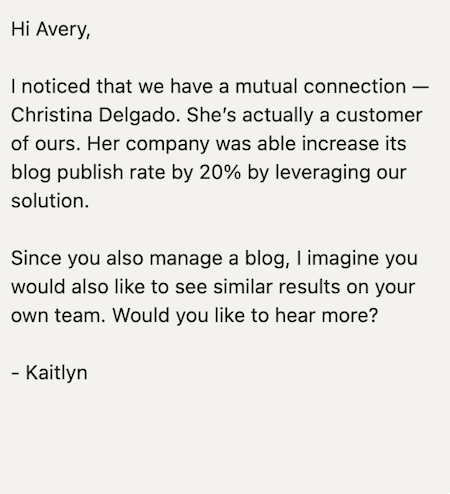
To fill the need, they developed the idea of a software solution for encoding data into inaudible tones. On a three-day, SXSW-bound, Cincinnati StartupBus, LISNR® was born, pitched, and moved to a seed round. Over the past 7 years, LISNR has raised over $35M and pioneered many advancements in ultrasonic technology, ultimately driving its usage in payments today.”
- It uses the company’s origin story as a storytelling device.
- It communicates the company’s values.
- It differentiates its product from others on the market.
- It shows how much the company has grown over time.
9. Follow-Up Pitch
So, what do you do if your prospect doesn’t respond to your first pitch? You follow-up with them. A follow-up pitch gives you the opportunity to reignite the conversation, reinforce your value proposition, and address any questions or concerns your prospect might have.
Follow-up pitches can be delivered through a number of channels, but phone calls and email are the most common. Ultimately, the goal of a follow-up is to continue nurturing your relationship with the prospect and convert them into a customer.
Here’s a great example of a follow-up after connecting with a prospect on social media:
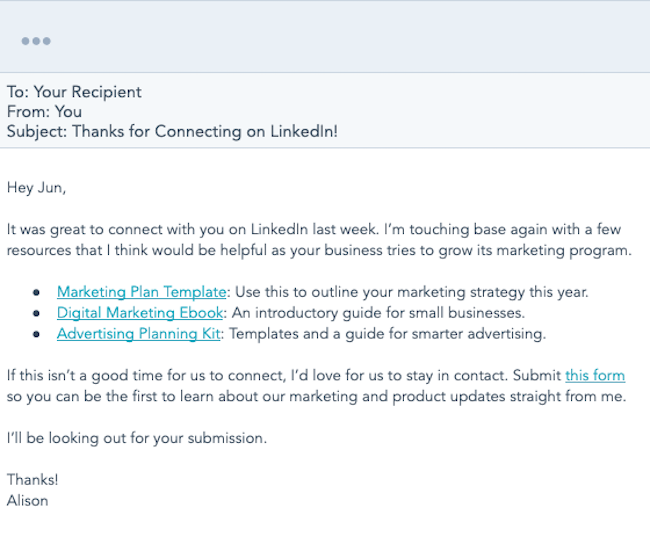
Don't forget to share this post!
Related articles.

Unique Selling Proposition: What It Is & How to Develop a Great One

5 Tips for a Great Sales Hook, According to Sales Reps

8 Expert Tips for Pitching to Investors
![how to write a pitch presentation How to Win a Deal on Shark Tank: The Anatomy of a Perfect Business Pitch [Infographic]](https://blog.hubspot.com/hubfs/________SHARK%20%281%29.jpg)
How to Win a Deal on Shark Tank: The Anatomy of a Perfect Business Pitch [Infographic]

5 Steps to Telling a Better Story in Your Next Sales Presentation
![how to write a pitch presentation 6 Essential Elements of a Successful Sales Pitch or Presentation [Infographic]](https://blog.hubspot.com/hubfs/sales-pitch.jpg)
6 Essential Elements of a Successful Sales Pitch or Presentation [Infographic]

6 Types of Sales Pitches Every Salesperson Should Know

The Best Sales Pitch Isn’t a Pitch at All

60 Sensory Words and Phrases to Spice Up Your Sales Pitch in 2020

Don’t Know the Answer? Try These 10 Tips for Thinking on Your Feet
Tailor-made pitch deck templates for every business need
Powerful and easy-to-use sales software that drives productivity, enables customer connection, and supports growing sales orgs
We use essential cookies to make Venngage work. By clicking “Accept All Cookies”, you agree to the storing of cookies on your device to enhance site navigation, analyze site usage, and assist in our marketing efforts.
Manage Cookies
Cookies and similar technologies collect certain information about how you’re using our website. Some of them are essential, and without them you wouldn’t be able to use Venngage. But others are optional, and you get to choose whether we use them or not.
Strictly Necessary Cookies
These cookies are always on, as they’re essential for making Venngage work, and making it safe. Without these cookies, services you’ve asked for can’t be provided.
Show cookie providers
- Google Login
Functionality Cookies
These cookies help us provide enhanced functionality and personalisation, and remember your settings. They may be set by us or by third party providers.
Performance Cookies
These cookies help us analyze how many people are using Venngage, where they come from and how they're using it. If you opt out of these cookies, we can’t get feedback to make Venngage better for you and all our users.
- Google Analytics
Targeting Cookies
These cookies are set by our advertising partners to track your activity and show you relevant Venngage ads on other sites as you browse the internet.
- Google Tag Manager
- Infographics
- Daily Infographics
- Graphic Design
- Graphs and Charts
- Data Visualization
- Human Resources
- Training and Development
- Beginner Guides
Blog Business
10 Business Pitch Examples for Your Next Client Meeting
By Letícia Fonseca , Oct 30, 2023
We tell presenters that it’s okay to feel scared during your upcoming sales pitch because investors will always be a pressing and intimidating bunch.
Great elevator pitches are similar to memorable stories. They intertwine visuals and narrative to keep the audience engaged. And it needs to be completed in the duration of an elevator ride.
In this guide, we share 10 business pitch examples you’ll want to use in your next investor or client meeting.
You don’t need design experience to create a business or sales pitch. Create an engaging presentation in just minutes with Venngage’s professionally designed pitch deck templates !
What is a business pitch?
A business pitch is a concise and compelling presentation that is delivered to potential investors, clients or partners to communicate the value proposition of a business idea , product or service.
The main goal of a business pitch is to persuade the audience to take a particular action, such as investing in the business, partnering with the company or purchasing the product or service.
When creating a business pitch, always remember that a well-crafted business pitch should be clear, concise and tailored to the specific needs and interests of the target audience. It should effectively communicate the value proposition and potential of the business idea, leaving a lasting impression on the audience.
To help smoothen the process for you, I’ve curated 10 business pitch deck examples you can use for your next client meeting. Keep scrolling to find out!
10 business pitch examples you can use:
Choose a simple and short elevator pitch template, guy kawasaki elevator pitch examples for business, modern pitch deck example, effective startup elevator pitch examples.
- Business idea pitch deck
Dark marketing pitch deck
Classic airbnb pitch deck.
- Statement yellow elevator pitch example
- Short franchise elevator pitch example
Nonprofit pitch deck
Your elevator pitch needs to address the biggest business concern: the sales funnel .
This simple pitch deck example gets to the heart of the business problem within just 12 slides. It’s short, sharp and to the point, enough to keep prospective clients interested.

This is a great sales pitch deck template to accompany a brief presentation. You can easily share your business model with investors or clients.
Customize this template by adding your branding and business information. Include data about your target audience and team members. This is information that potential investors need to know.
With a Venngage business account, you can access the My Brand Kit feature, including the Autobrand tool.
Add your website when prompted and the editor will import your logos, fonts and brand colors . You’ll be able to add your branding to all your designs with a single click.
Related: How to Create an Effective Pitch Deck Design [+Examples]
The Guy Kawasaki method for elevator pitch templates has been successful for numerous businesses. The minimal text keeps investors focused during the entire pitch.
Presenters can fully concentrate on sharing the key metrics and pain points of their target market. The pitch deck includes overviews that guide investors’ thoughts.
Venngage has two versions of the conventional Guy Kawasaki elevator pitch format. This gradient version is a bit more modern. It certainly draws the eye without overwhelming the design.

The template’s simple and minimalist-inspired design makes it easy to customize for any brand completely. You can swap out the gradient panels and add brand-relevant product images instead.
You can also use this non-gradient pitch deck template. This is an ideal way to highlight your brand colors.

Make the easily customizable pitch deck examples shared above your own by adding your text, data and graphs.
Creating a pitch deck just got easier. Venngage’s real-time collaboration allows multiple members to work on a design at once. Share instant feedback and design a winning sales pitch.
This unconventional pitch deck uses icons to tell a compelling narrative. Visuals can spice up presentation decks and give make them aesthetically pleasing.
This template works well for startups and small businesses demonstrating to investors their brand’s potential.
If the deck is too dark, you can switch out the panel colors and icons. Add your own research to make your sales pitch convincing.
Related: Everything You Need to Know About Picking and Using Brand Colors
Elevator pitch decks focus on quick, one-minute proposals to convince potential investors that you have something valuable.
This investor pitch deck example is excellent for a startup elevator pitch. With just five slides, this deck makes it easy to breeze through your business model.

The added charts make the proposal and presentation much more convincing. You can share the necessary details that investors will want to know about.
Import your data from Google sheets into the Venngage editor and easily create charts for your presentation.
Related: Everything You Need to Know About Pie Charts
Business idea pitch deck
How do you highlight your business model to a potential customer? You start with your value proposition.
The below pitch deck example opens with the business’ value proposition in the first slide. It also includes many elegant ways to showcase the brand. Plus, it provides essential business data to investors simultaneously.

You can use the business idea pitch deck template above as a guideline for a good sales pitch of your own or modify and adjust it to your branding needs.
The marketing pitch deck example below has a dark but unique personality. It works well in a product launch setting or as an elevator pitch deck for marketers.
The color combination is unusual but striking. Not to mention, on-trend. Bold colors are one of the resurgent graphic design trends of the past few years.

You can use the above marketing pitch deck example as inspiration for numerous business presentations.
Art and multimedia businesses can also use it as a template for client presentations.
Related: 20+ Business Pitch Deck Templates to Win New Clients and Investors
We all know what Airbnb is and how much the business has grown over the past few years.
One of the best pitch deck examples you’ll see is Venngage’s version of the Airbnb pitch deck.
It uses sample data, addresses the core customer problem and outlines the business plan to capture the audience’s attention.

The pitch deck example above is one of the standard elevator pitch decks but manages to be sophisticated. There’s a finesse to this pitch deck design . That’s why it was so successful.
Statement yellow elevator pitch example
The yellow motif of this artistic pitch deck will immediately hold the audience’s attention.
The color is bright and bold but isn’t overpowering. Instead, only two slides use the background color across the whole slide.
The majority of the slides only include hints of yellow or use it as a highlight.

This template works for companies that use one prominent color across their branding. It’s also a professional pitch deck for small businesses, startups, or software companies.
Short franchise elevator pitch example
Pitch decks don’t depend on length to make a point. Instead, it uses fewer headers as overviews and depends on presenters to share pitch details with investors.

This is one of the best pitch deck examples for a short and classy presentation. It uses a small number of icons and bullet points to draw the eye and keep the presentation flowing.
As an elevator pitch, this is an effective method for maintaining the audience’s focus.
Related: A Complete Guide to Line Charts
This elevator pitch example for nonprofits uses minimalism and icons to keep potential investors engaged throughout the presentation.

The subtle use of color and icons asserts the brand’s personality. This template can work for businesses in the graphic design sector.
Alternatively, the nonprofit pitch deck example above can also work for digital marketing agencies that want a cutting-edge appeal to make themselves attractive to clients.
Famous sales pitch decks to inspire your pitch
Minimalist airbnb pitch deck.
This minimalist design of the Airbnb elevator pitch example shared above is perfect for startups.
You can easily add product or location photos and adjust the colors to suit your branding, alongside your logo and fonts.

Buffer pitch deck
The real Buffer pitch deck was confusing for investors. You can read more about it in our round-up of the best pitch decks .
Venngage designed a cleaner version using icons and charts. This makes the information easier to understand. You aren’t bombarding your audience with too many details.
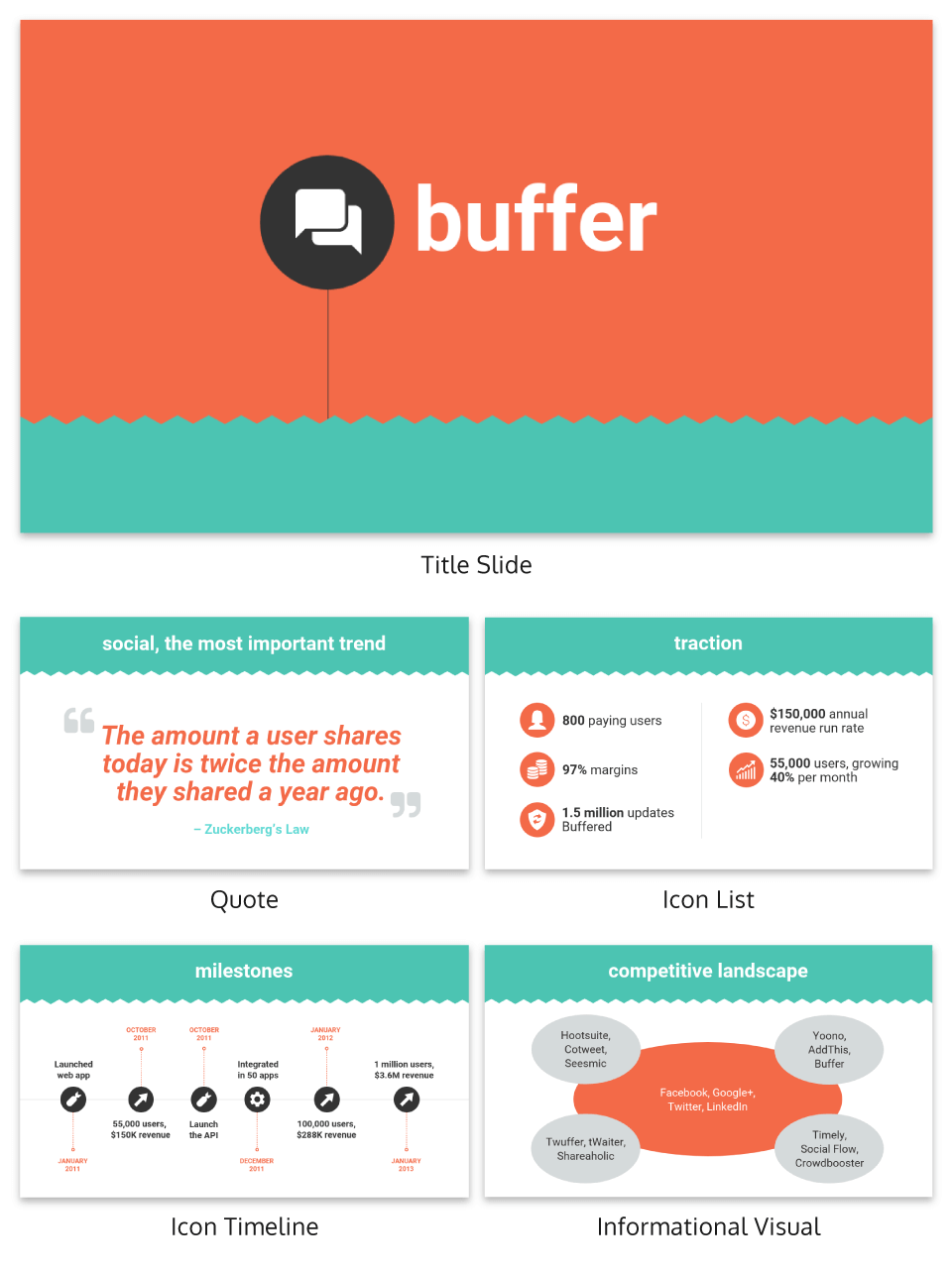
Facebook pitch deck
The winning Facebook pitch deck was text-heavy. But what made it stand out was how many popular schools had already signed up with it.
Plus, the deck was nothing short of ambitious, with a clear expansion plan. It is no surprise that Facebook is the behemoth it is today.
How to write a business pitch deck
Creating a compelling business pitch deck is essential for effectively conveying your business idea to potential investors or partners. Here is a step-by-step guide to help you write a business pitch deck:
- Cover slide: Include the name of your company and a visually appealing image that represents your business.
- Problem statement: Clearly define the problem your product or service solves. Use statistics or real-life examples to emphasize the significance of the problem.
- Solution: Describe your product or service and how it addresses the identified problem. Use visuals, such as product images or diagrams, to help illustrate your solution.
- Market opportunity: Present market research data to showcase the size, growth potential and trends of the target market. Use graphs, charts, or infographics to make the information more engaging.
- Business model: Explain how your business will generate revenue. Describe your pricing strategy, sales and distribution channels and any key partnerships or collaborations that will contribute to your business model’s success.
- Traction and milestones: Highlight any significant achievements, milestones, or partnerships that demonstrate the progress and potential of your business. This can include user metrics, revenue growth, or notable endorsements.
- Competitive analysis: Analyze your competitors and illustrate how your product or service stands out in the market. Highlight your unique selling points and any barriers to entry that provide your business with a competitive advantage.
- Go-to-market strategy: Outline your marketing and sales plan. Describe how you will reach and acquire customers, including your marketing channels, customer acquisition strategy and sales approach.
- Financial projections: Present your financial forecasts, including revenue projections, cost structures and expected profitability. Use charts or graphs to display key financial data and assumptions.
- Team: Introduce your team members and highlight their relevant expertise and experience. Emphasize how the team’s skills and strengths contribute to the success of the business.
- Use of funds: Explain how you plan to use the funds you are seeking. Provide a breakdown of how the investment will be allocated across different aspects of the business.
- Conclusion and call-to-action: Summarize the key points of your pitch and clearly state what action you want the investors to take. Encourage questions and provide your contact information for further discussions.
Remember to keep your pitch deck concise, visually appealing and easy to understand. Use high-quality visuals and compelling storytelling to make your business pitch deck engaging and memorable for your audience.
Four tips for creating a great elevator pitch
Here are four easy ways to recreate the pitch deck examples above or build your own pitch from a template.
Create a visual style for your sales pitches
A visual style or theme creates flow and sophistication in any presentation. These involve using recurring elements in a subtle and obvious manner.
For example, this Venngage template uses our color gradient along with elegant and bright icons.

Choose visual elements whose characteristics become the pitch deck’s focal point. Great pitch decks use the brand’s colors and visual motifs to keep the brand top of mind.
Give an overview of your business model
Pitch decks act as content anchors that guide your client toward your topic’s main points.
All the other information in your pitch deck or the explanations in your presentation will be aimed at supplementing that data.
Like this Uber elevator pitch template that emphasizes customer pain points and how the business will solve them.

Examples of added data include situational examples, charts and graphs and case studies .
Focus on your unique proposition
Your pitch deck has a central idea that is its unique selling proposition. Pitch deck creators build their pitch ideas around this aspect.
As a result, they’ll have a solid, communicative and persuading pitch deck that convinces investors.
Simplify hard concepts in your sales pitch
Scientific knowledge is enriching to those who understand its meaning.
Hard concepts, long-running and poorly constructed sentences and jargon make reading challenging for investors who have a very short time to spare.
This deck ensures that information isn’t overwhelming, either in the overview or the traction slide.

Make sure to simplify hard concepts and use simple words. That’s what the best pitch decks do.
Use templates to create successful pitch decks and win over investors
Delivering a good elevator pitch can be overwhelming. The pressure to get the tone right and impress investors is huge.
We’ve shared 10 elevator pitch examples that you can use as inspiration.
And with Venngage’s pitch deck templates, you get a competitive advantage. With no design experience, you can create elevator pitches that win over investors.
More From Forbes
How to create a pitch deck.
- Share to Facebook
- Share to Twitter
- Share to Linkedin
The pitch deck is a presentation that entrepreneurs put together when seeking a round of financing from investors. On average pitch decks have no more than 19 slides.
As described in my book, The Art of Startup Fundraising , ultimately founders need two different sets of pitch decks. One version will be with a lot of text and information which will be shared with people via email. The other version will be the pitch deck that entrepreneurs present to investors in person with more visuals. Having more visuals will contribute to having investors focused on you.
In essence, the three keys to powerful pitch decks that get funded are:
- Clear and simple
- Easy to act on
I do a deep dive on pitch decks in a piece that I published not long ago where I cover the pitch deck template that was created by Silicon Valley legend, Peter Thiel ( see it here ). Moreover, I also provided a commentary on a pitch deck from an Uber competitor that has raised over $400M ( see it here ). In any case, below are essentially the slides that you want to include inside your presentation:
- Competition
- Amount being raised
Note that according to research done by DocSend, investors spend on average 3 minutes and 44 seconds per pitch deck. From their study which analyzed 200 pitch decks, investors spent the most amount of time reviewing the slides concerning financials, team, and competition.
The slide covering the problem should be a way for you to explain what gap you are filling in the market. This needs to be a painful problem that people can relate to and that investors would not have issues with understanding.
Furthermore, you are only resolving one problem. Not two or three. You need to come across as someone that is focused and relentless to resolve a known issue.
Normally I would recommend startups to create different slides for the problem and the solution as you don‘t want to overwhelm the investor in one slide.
Note when an investor gets involved with your venture is either because one of the following things:
- They have experienced the same problem in the past
- There is a clear sense of ROI down the line for them
- Given their professional expertise they understand it (e.g. doctors with healthcare)
If an investor falls inside the three buckets of interest cited above at the same time, that means you got your lead investor. This may result in you securing at least 20% of the financing of the entire round that you are looking to raise.
2. Solution
The solution needs to be concise and very clear. Especially if you are a tech startup, your solution needs to be scalable. Scalability is the capability of a system to increase its total output under an increased load when resources are added. This is what investors essentially want to see. A company in which they can invest in order to have the wheel turn much faster.
Moreover, it makes sense on the solution to outline why it makes sense now. As you may know timing is everything in business and being at the right time in history is what really matters. Being too early or too late to market can be the main cause of failure for startups.
Avoid statements referencing you being the only one doing this, you being the clear leader, etc. Just like Mark Cuban puts it, there are at least 100 people that have come up with that idea before you and other companies that may be tackling that same problem with a different approach.
The market is going to determine the potential exit of the investor. If you are operating in a small market also the returns could be impacted by this.
Remember that any market that is under $1B might not be that attractive to an investor in hyper growth businesses. The reason for this is mainly because these investors are on the hunt for investment opportunities that may provide a 10x return in a horizon of 5 to 7 years.
Ultimate investors, and especially institutional investors, look for companies that will not only transform or disrupt their industry but have the potential to fundamentally reshape the way consumers interact with a market.
My recommendation is to show on this slide a graph that outlines the market growth in the past and the future potential growth so that investors can quantify the upside and potential ROI on their investment. Make sure you are including sources from research papers.
This slide is all about showing screenshots of your product in action. To make it even more powerful you may want to add some description about the product itself and some quotes of some of your existing clients talking about how much they love your product.
5. Traction
This slide should show the month over month growth of the business (e.g. revenue, metrics, etc). This is the slide where you would include hopefully the famous hockey stick that investors want to see on every pitch deck they review. Getting to this type of “promise land“ for startups is not easy.
In the event you are very early stage or your growth is not that interesting I would avoid including it. To give you an idea, accelerator programs like Y Combiner expect at least 15% month over month growth.
The team is probably one of the most important slides in any pitch deck. The investor wants to know who is driving the bus and what makes them so unique to execute on that mission and vision. Note there are at least 100 other people that have also thought about your same idea. For that reason idea is 10% and 90% is from execution.
If you have the right people seated on the right seats of the bus the company will end up finding its direction to success. Unfortunately when you are investing in a first time founder you are also investing in that individual‘s education and all the mistakes he or she will make during the early days. This is always part of the journey and there is no way to go around it.
The best way to showcase the team slide is by just describing the members of the leadership team (ideally cofounders). List in bullet points what have been the two or three achievements from every member. Ideally those would be related to the company that is seeking capital.
7. Competition
A diagram is a good idea to show the investor the competitors that you have executing in your space. How you compare to them and where you land with your value proposition.
You want to clearly differentiate yourself from the rest so that the person that is reviewing the slide gets what makes your company so unique.
Perhaps another slide that you want to include is one that describes how much capital each competitor has already raised in the past and at what valuation. This could help in providing some perspective of how much the market is paying. This could also play in your favor when the time comes to negotiate the terms of the deal or proceeding with a potential investment.
8. Financials
Normally you want to shoot for at least 3 years of projections. There are some institutional investors that even ask for 5 years of projections but in my experience these investors tend to be the least sophisticated ones.
Even though projections are a shot in the dark when you are dealing with startups, they do provide a good idea of where the business is heading and potential outcomes. It also give a good idea to the investor as to how grounded the management of the the company is.
This slide is more important than entrepreneurs normally think. When you first connect with an institutional investor they will ask for your pitch deck. 3 months later they will ask you on your next meeting where things are at and then they will make a decision. With this in mind, it is always a good idea to be more on the conservative side and to over deliver. Worst thing that can happen is for you to completely miss the mark and under promise.
Additionally you will need to have ready your financials in Excel format as investors may want to see that after reviewing your pitch deck. For that reason you do not need to go into much detail on the deck. All you need is to provide a summary.
9. Amount being raised
On the ask slide you want to be strategic. Do not put a specific amount that you are raising. For example, if you would like to raise $5 million, I would suggest putting a range between $3 million and $5 million. Firms have limitations on their investment which means that if you place $5 million in your pitch deck and that firm has a mandate to not invest over $3 million, you will most likely have them pass. By including the range from $3 million to $5 million on the raise amount you are also including such firms. For that reason you want to be attractive to as many targets as possible, so go with ranges instead of specific amounts.
Most founders forget to include in their pitch deck their contact information. If you have a large following on social media you should include the links on the cover slide. I find this would provide social proof. Interested investors will most likely look you up and will also reach out to people in common in order to ask for references.
If you are serious about your pitch deck it is not a bad idea to ask someone with a high-level understanding of sales psychology to take a look at your deck. A couple of tweaks to images, placement, and words could make a multi-million dollar difference.
- Editorial Standards
- Reprints & Permissions
- Crimson Careers
- For Employers
- Harvard College
- Harvard Kenneth C. Griffin Graduate School of Arts & Sciences
- Harvard Extension School
- Premed / Pre-Health
- Families & Supporters
- Faculty & Staff
- Prospective Students
- First Generation / Low Income
- International Students
- Students of Color
- Students with Disabilities
- Undocumented Students
- Explore Interests & Make Career Decisions
- Create a Resume/CV or Cover Letter
- Expand Your Network
- Engage with Employers
- Search for a Job
- Find an Internship
- January Experiences (College)
- Find & Apply for Summer Opportunities Funding
- Prepare for an Interview
- Negotiate an Offer
- Apply to Graduate or Professional School
- Access Resources
- AI for Professional Development and Exploration
- Arts & Entertainment
- Business & Entrepreneurship
- Climate, Sustainability, Environment, Energy
- Government, Int’l Relations, Education, Law, Nonprofits
- Life Sciences & Health
- Technology & Engineering
- Still Exploring
- Talk to an Advisor
How to Give a Great Elevator Pitch (With Examples)
- Share This: Share How to Give a Great Elevator Pitch (With Examples) on Facebook Share How to Give a Great Elevator Pitch (With Examples) on LinkedIn Share How to Give a Great Elevator Pitch (With Examples) on X
How to Give a Great Elevator Pitch (With Examples) was originally published on Forage .

Though people are complex and so much more than just their jobs, in a new social situation you’re often asked, “So, what do you do?” or “What are you majoring in?” While you probably have a stock answer ready to go (I’m in sales; I’m majoring in English), the person asking may be able to help you achieve your career goals — but they won’t know unless you’ve got an elevator pitch ready to go.
An elevator pitch is an enticing and interesting three or four-sentence summary of you. But you do more than talk about yourself. Your elevator pitch gets the listener interested in what you’re capable of.
In this guide, you’ll learn:
What Is an Elevator Pitch?
How to write an elevator pitch, elevator pitch examples, elevator pitch bonus tips.
Mike Gardon of CareerCloud sums up elevator pitches like this: “When meeting someone for the first time, we all get asked what we do, right? Well, an elevator pitch is how you answer that question.”
At its core, an elevator pitch is a brief synopsis of who you are and what you do (or are trying to do). It’s named so because of the idea that you’re in an elevator with the one person who can make your career dreams come true. You’ve got the length of that elevator ride (approximately 30 seconds) to convince that person to keep listening to you.
Why You Need an Elevator Pitch (and When You’ll Use It)
In many respects, an elevator pitch is all about you. And though it may seem strange — uncomfortable even — to talk about yourself, a well-designed elevator pitch starts with you and ends with the listener.
Gardon explains, “The elevator pitch is designed to engage the person with whom you are communicating, and get them to take some next action. Think about it like this: if you were writing an email, the elevator pitch would be the subject line plus the next couple of lines that are shown in an inbox. The purpose is to get the recipient to open the email.”
In the case of your elevator pitch, you’re attempting to spark a longer conversation (or later meeting) with someone who could potentially help you professionally.
Showcase new skills
Build the confidence and practical skills that employers are looking for with Forage virtual work experiences.
Sign up for free
Your elevator pitch comes in handy when you’re looking for a job. But you’ll also use various versions of your elevator pitch in situations like:
- Networking events
- Prospecting for new sales and clients
- When you’re interviewing and asked, “Tell me about yourself.”
- As the “about me” on LinkedIn, Twitter, or other social media page
- In the summary of qualifications on your resume
How Long Should an Elevator Pitch Be?
While elevator ride times vary, the general rule of thumb is that an elevator pitch is no longer than 30 seconds, which means your pitch needs to be concise.
So, you can’t include every accomplishment from your last three jobs, just the top most recent ones. As you’re honing your pitch, write it down and limit yourself to four sentences. This will help you focus on your top highlights.
In general, an elevator pitch includes four essential elements: who you are, what you do, what’s unique about you, and what your “ask” is. Though the “meat” of your pitch likely doesn’t change often, you should prepare multiple elevator pitches that you can tailor to your situation.
For example, if you’re a student, the pitch you use at a career fair may not be the same one you use at a networking event. Likewise, if you’re changing careers, you may need to switch up what your “ask” is depending on who you talk to.
Gardon offers an example. “I wear so many different hats and am involved in different businesses. So, if I want someone to be a guest on my podcast, I might tell them how we’ve done over 400 episodes, instead of telling them that I’m a former derivatives trader.”
Also, while the below elements are crucial, they can go in almost any order. While a good elevator pitch usually begins with your name, you may find that listing your skills before your accomplishments is better for your pitch.
Part 1: Who Are You?
Your elevator pitch starts with your name, of course, but also consider throwing in a “hook” that gives the person you’re speaking with an opening to ask you questions. Here are some examples:
“I’m [your name], a recent graduate of [university] with a degree in [your degree].”
“My name is [your name] and I’m a junior at [university] majoring in [your major].”
“I’m [your name] and while I’m currently in product development, I’ve decided I want to change gears and go into graphic design.”
Part 2: What Do You Do?
The second part of your elevator pitch explains what you do. However, you shouldn’t limit yourself to a job title. This is the place to mention one outstanding accomplishment from your job, internship, or even a class that will wow your listener.
Like all parts of your elevator speech, this needs to be brief, but it should also be detailed and help the listener get an idea of what you’re capable of:
“During my marketing internship at [name of company], I grew social media engagement by 43%, which resulted in an uptick in newsletter sign-ups year over year.”
“Our business is small, but that lets us have more personal interaction, which has helped us keep a small but loyal and profitable client base for 15 years.”
“After learning about the stock market, I wanted to test what I learned as well as my skills, so I created a mock portfolio that’s realized a 24% gain over the last year.”
Part 3: What’s Unique About You?
The next section of your elevator pitch includes something unique about you. While this can include specific skills, you can also trace your career path or accomplishments to illustrate how you use your skills.
Because you only have 30 seconds, you might be tempted to list your skills or accomplishments like a grocery list. But try to link them to an outcome or something you can do.
“I enjoy analyzing data and using the results to plan my content calendar, including social media posts.”
“I worked on my college newspaper, starting on the sports beat, eventually moving my way up to chief editor.”
The first example mentions one skill (data analysis ) and two outcomes (planning the content calendar and social media posts). The second example doesn’t mention any skills but illustrates the speaker’s career path (sports beat to chief editor), demonstrating an increase in skills and responsibilities.
>>>>>> Ready to level-up your data analysis skills? Try the Data & Analytics Virtual Work Experience
Part 4: Call to Action (or What’s Your Ask?)
The final part of your elevator pitch includes a call to action. Or, more specifically, what are you asking for?
Much like networking, you may not want to blurt out “a job!” even if that’s your desired outcome. This section is what you hope will happen, which could be a job, internship, or just a new networking connection.
“I would love to speak to you about being a potential mentor, if you have time.”
“I’d like to follow up with you about how I can get involved in and conduct summer research.”
“Can you tell me how you decided on [this] career?”
Each of these invites the listener to continue engaging with you either right now or in the future.
Optional Part 5: Something Memorable
Finally, depending on the situation, you might want to include something memorable in your pitch. This is situation-dependent and only something you should do if you’re comfortable.
For example, the pitch on Gardon’s LinkedIn profile says, “Earned the Title ‘World Champion Funniest Person In The World (to my kids)’ 10 years running.”
Of course, not everyone can be the “Funniest Person in the World,” but your memorable moment could be your love of science fiction, who your favorite author is, or the fact that you just adopted a cat.
Here’s what all the elements look like when you put them together:
“I’m David, a rising senior at XYZ University and an education major. I spent last year student teaching at my old high school, and it was quite the experience being on the other side. I’m graduating in the spring and am looking to teach high school biology.”
“I’m Ella, and I’m currently an individual contributor at XYZ company running the social media accounts. I use Google Analytics to analyze and improve content performance, and my personal TikTok has XXX followers. I’m looking to move to a leadership role at a mid to large-size company where I can mentor others.”
“I’m Mike and I’m a sophomore at XYZ university. When I was a kid, I really wanted to communicate with animals, which is partly why I’m majoring in zoology. I’m not sure what career is best suited for me. Can you tell me how you ended up in yours?”
Once you’ve written (and rewritten) your elevator pitch, you’re almost ready to try it out. Before you do, though, ensure your delivery is memorable — for the right reasons!
- Practice. Practice makes perfect, of course. And while you don’t want to sound too rehearsed, you also don’t want to trip over your pitch or start rambling. Practice in front of a mirror, with friends or family, or record yourself to make sure you’re getting it right.
- Time yourself. Thirty seconds can feel like forever or fly right by. Time yourself to make sure your pitch isn’t too long or too short, and adjust as necessary.
- Use your “excited” voice. While you’ll want to use your “inside voice,” vary your tone. When you give a rehearsed speech, it should be polished but not robotic. Try to bring some excitement to your voice as you speak.
- Speak slowly. You may want to cram as much as possible into your 30 seconds, but that could result in you speaking too quickly to try to get it all in, making it tough for the listener to understand you. As hard as it might be, stick to one or two main points.
- Maintain eye contact. While you don’t want to stare at the listener the whole time, you don’t want to stare at the floor either. Maintain the level of eye contact that feels normal and natural to you, and break eye contact when appropriate.
Make Your Pitch
An elevator pitch is useful in all sorts of professional (and even personal!) situations. By taking stock of what you do and what you want to do, you’ll find the perfect elements to include in yours and impress the next person you pitch it to.
Want more insights into creating the perfect pitch? Check out Ashurst’s Building Your Personal Brand Virtual Experience Program .
Image credit: Canva
The post How to Give a Great Elevator Pitch (With Examples) appeared first on Forage .
- Starting a Business
- Growing a Business
- Small Business Guide
- Business News
- Science & Technology
- Money & Finance
- For Subscribers
- Write for Entrepreneur
- Entrepreneur Store
- United States
- Asia Pacific
- Middle East
- South Africa
Copyright © 2024 Entrepreneur Media, LLC All rights reserved. Entrepreneur® and its related marks are registered trademarks of Entrepreneur Media LLC
2 Ways to Instantly Improve Your Pitch By improving the start and finish of your pitch you can instantly help stand out from the crowd and increase your chance of raising venture capital.
By Liam Gill • Apr 5, 2024
Key Takeaways
- These two tactics have been used to raise millions in venture capital.
- A perspective framer instantly reframes the way investors would analyze the business.
Opinions expressed by Entrepreneur contributors are their own.
Effective communication of what your business does and why it matters is vital for entrepreneurs wanting to raise capital and attract investors. However, today, when most founders receive pitching advice from the same few sources, every pitch has started to sound generic, with the same tone, structure, and reveal.
Today, I want to discuss two tactics that my clients have used to raise millions in venture capital that are not "common practice" and instantly help them improve their pitch by making it clearer, stronger and unique.
Related: 5 Phrases That Kill Your Chances of Receiving Funding
1. Using a perspective framer
99% of pitches start with the problem. You'll often hear founders dive deep into a problem that they experience or that those around them experience while explaining the pain points to an investor. The problem with this is that if the investor can't relate to the problem, they immediately become disengaged. This isn't just an observation; data back it.
Per Harvard University, 11% of investing partners at VC firms are females; consequently, 13% of venture capital investment dollars are given to startups with female founders. Fundamentally, when a woman comes to pitch a solution to a problem faced by women, unless there is a female investor there to hear the pitch, most men don't understand the problem. The proof is in the data, as when VC firms increase the number of female investors, those firms suddenly see higher returns and more exits on investments in female founders.
So, how can you solve this problem using a perspective framer? A perspective framer should be the first content slide (the second slide after the title slide) in your pitch. It should tell the investor how to look at the rest of the deck . The objective is to get them to view your company not through the lens of their own experiences and bias but through the lens that best demonstrates its potential and impact.
Here is an example of a perspective framer from a past client: "Have you recently been sent a news article or seen a link on Twitter and clicked it just to be hit with a paywall? If so, you are not alone. Every day, billions of people like you are blocked from reading the news.
Now, do you remember that headline? Did you share it with someone else? Were you able to verify if it was true?
Today, 76% of publishers use paywalls. They are incentivized to use clickbait headlines to drive purchases. These headlines innocently shared by billions of people just like you are fuelling an epidemic of misinformation causing political instability, promoting violence and, in the last few years, contributing to the death of millions of people.
If someone could alter the incentives for publishers and make complete news articles affordable for all, they would not only revolutionize the $36B news industry but solve a major social crisis." This perspective framer instantly reframed the way investors would analyze the business. They would no longer see a news subscription service and decide whether to invest based on their personal interest in using the product. Instead, they saw a company solving a massive social issue in a huge market. The rest of the deck is interpreted through their ability to solve this social issue and capture that market, not the investor's chances of becoming a customer.
Related: Avoid These 9 Pitch Deck Mistakes When Asking Others For Money
2. Showcase your offer
The biggest problem I see with many pitches is that no matter how great they are, they always finish with a feeling that the entrepreneur is begging for money. It rarely comes across as a can't miss investment opportunity, and instead, it feels like I'm being asked to fund someone's dream. The reason for this is simply that entrepreneurs have been conditioned to frame their offer as an "ask." In the venture capital world, it is even common practice to name the slide "The Ask." This puts the founder at a huge disadvantage. Nobody asks if they can help you make money; they offer to help you make money. They ask for money when they need it.
Instead of having an ask at the end of your pitch, make sure to showcase your offer. What is the difference?
- Don't present your company as "needing" them money to accomplish anything. Use an active tone to pitch your company, discuss how you are already on a path to $1B+ business and that these funds will accelerate the process (but you are going to get there no matter what).
- Leverage the trends around you to create a fear of missing out. If you make it seem as if this opportunity will only exist for a short period because of technological advancements, legal changes, social trends, etc., then this time-pressure investment seems more like a shrewd opportunity than a donation.
Related: If You Want Your Pitches to Improve, Use These 3 Simple Tips
Entrepreneur Leadership Network® Contributor
Creator of the Fundraise Operating System
Want to be an Entrepreneur Leadership Network contributor? Apply now to join.
Editor's Pick Red Arrow
- A Student in an Ivy League University's Most Popular MBA Leadership Class Asked a Tough Question: What If Your Boss's Downfall Is Necessary to Get Ahead?
- Lock Zillow Co-Founder Shares a 'Misunderstood' Truth About Starting, Funding and Selling Your Company
- Lisa Vanderpump Says If You Want to Run a Business, Get Some Thicker Skin
- Lock These Are the 10 Best States for Starting a Side Hustle , New Research Reveals
- Popular Appetite Suppressant Ozempic Can Be Made for Less Than $5 a Month , New Research Suggests
- Lock Bankruptcy Isn't a Sign of Failure — It's a Strategy. Here's Why It Might Be the Right Move for You .
Most Popular Red Arrow
I've had a secret side hustle for decades. it keeps tens of thousands of dollars in my pocket — and gets me into places i wouldn't go otherwise..
When Cliff Smith lost his job, he picked up an under-the-radar gig that would make it possible to keep dining out — something he and his wife love to do.
Save $100 on Lifetime Access to an App That Makes It Simpler to Eat Healthy and Lose Weight
Don't miss this discounted solution toward achieving health goals.
5 Ways You Might Be Cheating on Your Taxes — And Why You Will Get Caught
Are you cheating on your business taxes — or thinking about it? Think again.
Save More Than $600 on This AI-based App That Creates Written Content, Images, and Voiceovers
Save time and expand your impact with these innovative tools.
Elon Musk Is Mysteriously Re-Verifying X Accounts as the Platform Cleanses Bots, Spam
Some users noticed that blue checkmarks had re-appeared on their accounts this week.
6 Marketing Lessons Small Businesses Can Learn From the Big Players
Here are six major takeaways you can apply to your next product launch.
Successfully copied link

IMAGES
VIDEO
COMMENTS
Pitch Deck Presentation Templates. This template pack has 3 incredible slides that would fit perfectly into any Pitch Deck. First, its vision and mission slide will allow you to give your audience a more in-depth look at what your business is really about. It also has a great geometrical process diagram.
What Makes a Great Pitch. by. Michael Quinn. May 06, 2020. Eric Dreyer/Getty Images. Summary. A good pitch is a balancing act that can be adjusted to the currents in the room. A recent survey of ...
3. Make it a standalone deck. A potential investor may want to refer to the pitch deck after the presentation. Ensure that the deck contains the most critical information they need in print or PDF format. 4. Keep it updated. Businesses typically pitch many potential investors before they secure funding.
Quick Read. A pitch deck is a visual presentation that tells the story of a business to persuade and engage potential investors. The most common pitch deck slides are introduction, problem, solution, market size and opportunity, product, traction, team, competition, financials and use of funds. Learn from the eight real life pitch deck examples ...
Audience interaction. Question prompts: To make your pitch presentation more interactive, encourage audience participation and questions. Read the room: Always be aware of the audience's reactions and adjust accordingly. If they seem disinterested, you might need to change your approach or pace. As a pitch deck presenter, your role is to deliver your content in a way that makes an impact.
The first may be the one you create to pitch potential cofounders to join you on the team. In this type of presentation, you'll likely want to focus on the company's mission, the culture they'd be joining (or helping to establish), and the growth potential they have a chance to be a part of. The second type would be a comprehensive deck ...
Identify and address the target audience and/or industry your product supports. Specify the problem the aforementioned faces and how your solution can solve it. Provide a realistic example of your solution in action. Make sure to use accurate facts backed up by relevant and recent data. 4. Job pitch.
Use an infographic to explain the steps in your business or how the parts of your company fit together. Check out infographic elements and chain them together to jazz up a presentation. 3. Add a SWOT Slide for Visual Strategies. One of my favorite visuals for a pitch deck is a SWOT slide.
It comes down to completing four simple sentence starters: 1) What if you could…. 2) So that…. 3) For example…. 4) And that's not all…. You may not have "marketing" or "sales" in ...
The aim is simple: keep your copy simple, succinct and to the point. A presentation deck is no place to be wordy. Instead, limit to 6-8 lines per slide — roughly 30 words per slide. You can also try the 5 x 5 x 5 rule of writing presentation copy: 5 lines of text per slide with. 5 words per line and placing only.
6 essential components of a pitch deck. No matter what stage of funding your company is at, your pitch deck will need to cover each of these topics: Your mission or vision. The problem you're ...
1. Read the submission guidelines. The first step when writing a pitch is to ensure you're abiding by the guidelines for submitting the pitch. If the business you want to pitch to has a set of submission guidelines, start by reading through them to make sure that you're following them precisely. Once you're familiar with the guidelines, you can ...
Follow these steps when creating your product pitch: Carry out your research, set clear objectives, make your opening captivating and communicate the benefits of the products. Use storytelling, back up your pitch with facts, address objections and include a call to action.
A pitch deck presentation is a slideshow that introduces a business idea, product, or service to investors. Typically consisting of 10-20 slides, a pitch deck is used to persuade potential investors to provide funding for a business. ... (I could write a whole article about using icons in your presentations correctly. There are so many ways ...
What is pitch deck? A pitch deck is a 10-20 slide business presentation designed to give a short summary of your company, your business model, your traction, and your startup vision. A pitch deck can be used for several purposes, from trying to get a meeting with an investor, to presenting in front of an audience during a demo day.
1. Use a Template to Save Time. Crafting a great pitch deck from scratch is time-consuming. With the right PowerPoint template, you can not only save time, but also get a professionally designed deck that already has all the necessary slides in place. All you've got to do is customize the design and add your own copy.
8. Appeal to emotions. Understanding your customers is central to consistently nailing sales pitches, and when you do, it's good to convey that. One way to do so is to use empathy, revolve your pitch around their life experience, and find commonalities between you and them.
10 business pitch examples you can use: Choose a simple and short elevator pitch template. Guy Kawasaki elevator pitch examples for business. Modern pitch deck example. Effective startup elevator pitch examples. Business idea pitch deck. Dark marketing pitch deck. Classic Airbnb pitch deck. Statement yellow elevator pitch example.
This guide is to be used with our Pitch deck template, which is designed for entrepreneurs who have never created a pitch deck before. The template has 15 generic pitch deck slides and 5 slides with icons. It's available in six colours and structured in a way that allows easy customisation. You just need to replace the placeholder text with ...
To make it even more powerful you may want to add some description about the product itself and some quotes of some of your existing clients talking about how much they love your product. 5 ...
Part 1: Who Are You? Your elevator pitch starts with your name, of course, but also consider throwing in a "hook" that gives the person you're speaking with an opening to ask you questions. Here are some examples: "I'm [your name], a recent graduate of [university] with a degree in [your degree].".
1. Be Concise and to the Point. A good business pitch requires you to provide crucial points regarding your business. You can use statistics and visual presentation to explain your issues. Simplify the expression and ensure that the investors understand the facts right away.
Fundamentally, when a woman comes to pitch a solution to a problem faced by women, unless there is a female investor there to hear the pitch, most men don't understand the problem. The proof is in ...
Elevate your business presentation with our sleek and sophisticated black and white PPT template, perfect for business professionals seeking a polished look for their pitch deck. Designed with simplicity and professionalism in mind, this PowerPoint and Google Slides template provides a clean backdrop that allows your content to shine.
Mar 03, 2023. An effective sales process has seven cyclical steps; prospecting, preparation, approach, presentation, overcoming kickbacks, closing the sale, and following up. Every step is as important as the next for landing a client or closing a deal. However, in your sales pitch presentation, you make a solid case for your product or service.